Arbejdsrapport fra Miljøstyrelsen Nr. 23 2007
Impact of CO2 quota allocation to new entrants in the electricity market
Contents
- Allocation to new entrants is an investment subsidy
- Model assumptions
- Impact on investments and CO2-emission
- Economic consequences
- Impacts on the price of CO2 in the EU ETS
- Targets for renewable energy
- Conclusions
- 3.1 Fundamentals of the EU ETS
- 3.2 Allocation to new entrants
- 3.3 NAP changes from 2005-7 to 2008-2012
4 The electricity market - impacts of allocation to new entrants
- 5.1 Modelling tool
- 5.2 Key assumptions
- 5.3 Welfare-economic losses
- 5.4 Investments in electricity generation capacity
- 5.5 Impact on electricity prices
- 5.6 Emitted CO2
- 5.7 Additional simulations
- 6 % discount rate
Appendix A: Background paper on modelling tool and data assumptions
Preface
In the summer and autumn of 2006, Ea Energy Analyses examined the consequences of allocating free CO2-allowances to new entrants in the EU emissions trading scheme for the Danish Environmental Protection Agency.
The present report summarises this work.
Christian van Maarschalkerweerd and Stefan Krüger Nielsen, the Danish Environmental Protection Agency, has supervised the work. In addition Sigurd Lauge Pedersen from the Danish Energy Authority has participated at project meetings.
The following team, from the consultants, has conducted the study:
- Hans Henrik Lindboe, Ea Energy Analyses
- Jesper Werling, Ea Energy Analyses
- Anders Kofoed-Wiuff, Ea Energy Analyses
- Lars Bregnbæk, subcontracted from Energy Modelling
Summary and conclusions
- Allocation to new entrants is an investment subsidy
- Model assumptions
- Impact on investments and CO2-emission
- Economic consequences
- Impacts on the price of CO2 in the EU ETS
- Targets for renewable energy
- Conclusions
In 2003, the EU adopted a directive on a greenhouse gas emissions trading scheme (ETS) encompassing all major energy-producing units and the majority of the energy-intensive industry. The EU ETS is based on the recognition that creating a price for carbon through the establishment of a market for emission reductions provides the most cost-effective way of complying with international greenhouse gas commitments (EU 2005, EU action against climate change).
All countries have opted to allocate CO2-allowances to new power plants. The present project explores the consequences of allocation to new entrants on market players’ investments in the electric market, the welfare-economic consequences and impacts on long-term CO2-emission from the electricity sector.
Allocation to new entrants is an investment subsidy
Allowances for existing and new incumbents are specified in national allocation plans covering EU-defined trading periods. The first period goes from 2005-7, and the second runs synchronously with the Kyoto commitment period from 2008-2012. The national allocation plans are made in accordance with guidelines from the European Commission, but Member States have a high degree of flexibility in their national plans.
In Figure 1, the allocation to a new coal-fired combined heat and power (CHP) plant is compared for five North European EU countries (based on the National Allocation Plans for 2005-7[1]). The EU directive does not require Member States to allocate allowances for free to new entrants, however, all countries have chosen to do so – possibly to attract investments to the power sector, or with the intention to ensure a level playing field between existing plants and new entrants. It appears from Figure 1 that even with a moderate CO2-allowance price of 20 euro/tonne, the income from the sale of allowances is able to cover a considerable part of the total capital costs of a new plant – in Germany more than 60 per cent. This is a substantial investment subsidy.
According to EU rules, only fossil fuel plants may be allocated quotas. This skews investments in the direction of fossil fuel technologies and away from renewable energy, thereby potentially eroding the incentives of the scheme.
Moreover, in some countries such as Germany and Finland, fossil fuel technologies with high emissions (coal power) are allocated relatively more allowances than technologies with low emissions (gas power). This distorts investments in the direction of more polluting fossil fuels, exacerbating the effect on CO2 emissions. Furthermore, subsidies differ substantially between countries; this may skew the geographical distribution of new investments in the electricity sector.
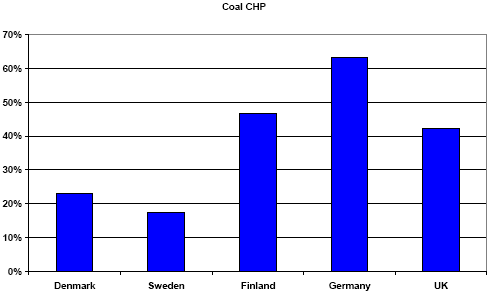
Figure 1: Allocation to new coal-fired plants in selected EU countries. Measured as share of the plants’ total capital costs assuming a CO2-allowance price of 20 euro/tonne, the value of future allowances has been reduced to net present value using a discount rate of 10 per cent over a time scale of 10 years. Based on the National Allocation Plans for 2005-7.
To explore the consequences of new entrant allocation on the power market model, analyses were carried out examining future investments in the German and Nordic electricity and heat markets from 2006-2022. The modelling area represents 30 per cent of EU-25 electricity demand (incl. Norway) and 23 per cent of CO2-emissions from the EU-25 power/heat sector.
Calculations were made using the Balmorel model (see, www.balmorel.com and appendix A), which is a partial equilibrium modelling tool containing detailed information on the electricity transmission system and power/heat plants in the countries covered by the analysis.
Model assumptions
Investments are assumed to take place in a market with perfect competition and no subsidies or other incentives except for the CO2-scheme. Fuel prices in the reference analysis are based on the latest projection by the IEA (World Energy Outlook 2006) and a CO2-price of 20 euro/tonne is applied. Moreover, thermal power plants are expected to be gradually decommissioned at a rate of 3 per cent per annum due to ageing, and nuclear power is assumed to be gradually phased out in Germany.
| Oil price | Gas price | Coal price | CO2-price | Investor rate of return |
| 48 $/bbl | 5.55 $/MBtu | 56 $/tonne | 20 €/ tonne | 11.75% per annum |
Table 1: Key parameters in modelling analyses
Impact on investments and CO2-emission
Under reference conditions – i.e. with CO2-costs of 20 euro/tonne but without allocation to new entrants – new investments are made in a combination of coal, gas and wind power. Over the period 2006-2022, investments in coal power amount to 32,000 MW, investments in gas power technology make up 17,000 MW and wind power 8,000 MW.
When including allocation of CO2-allowances to new power plants, investments are made almost exclusively in coal power. Over the 2006-2022 interval, new coal-power capacity almost doubles compared to the reference. Investments are made in 60,000 MW coal power at the expense of investments in gas power, which declines from 17,000 to 1,000 MW and new wind power, which is reduced from 8,000 MW to 2,000. In total, investments in new power capacity are increased by 6,000 MW because the new entrant allocation works as an investment subsidy.
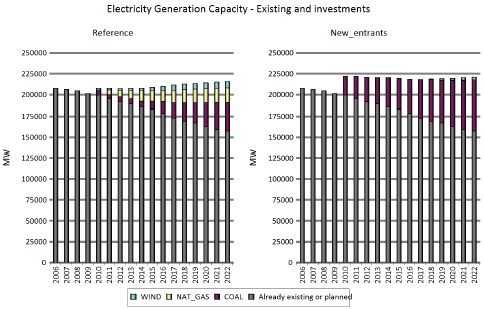
Figure 2: Investments in new capacity with allocation to new entrants and without allocation to new entrants (Reference). Due to the long lead time of new power plants, the model is only allowed to invest from 2010.
Due to the favourable allocation principles for new power plants in Germany, investments here increase by almost 10,000 MW in the case with new entrant allocation, whereas investments in the Nordic countries are reduced.
The nuclear phase-out and slightly increasing electricity demand lead to a rise in total CO2 emissions, both in the reference case and in the situation with allocation to new entrants. The increase is most profound in the case with allocation owing to the move from gas and wind to coal power. In total, annual emissions are approx. 40 Mt higher in 2022 with new entrant allocation.
For comparison, the model shows that the total savings induced by the EU emissions trading scheme are app. 100 Mt in 2022 assuming a CO2-price of 20 euro/tonne (see Figure 3).
Figure 3: Development in CO2-emissions from Germany and the Nordic countries, 2006-2022. Three developments are examined: 1) Scheme with no allocation to new entrants (Reference), 2) with no CO2-scheme and 3) with allocation to new entrants.
Economic consequences
Though allocation to new entrants does not directly affect the dispatching of power plants in the electricity spot market, the investments in new-generation plants do affect long-term price levels. The additional capacity applied in the simulation with new entrant allocation reduces the number of hours where expensive peak-load facilities need to be in operation.
This effect is most evident in Germany, where the largest number of additional investments is undertaken. Here electricity prices decline from a level of almost 50 euro/MWh to 40 euro/MWh, driving down the profits of existing electricity producers. Consumers, on the other hand, will benefit from new entrant allocation because of the lower electricity prices.
The model is capable of assessing the economic consequences for relevant groups of players, including electricity consumers, electricity producers and grid owners (congestion rents). The entire welfare-economic consequence of measures equals the sum of the consequences for the individual groups (see Table 2).
For the modelling area as a whole allocation to new entrants leads to a welfare-economic loss of €4.1 bn, when reduced to 2006 (net present value). This corresponds to approximately 25 per cent of the total investments in the electricity sector over the period 2006-2022.
| MILLION EURO | DENMARK | FINLAND | GERMANY | NORWAY | SWEDEN | TOTAL |
| Producer | -1,003 | -1,218 | -33,262 | -2,385 | -2,712 | -40,579 |
| Consumers | 954 | 1,387 | 29,535 | 2,510 | 2,995 | 37,381 |
| Grid owners | -72 | -151 | -249 | -43 | -398 | -915 |
| Total | -121 | 18 | -3,976 | 82 | -115 | -4,112 |
| Allocation to new entrants | 282.5 | 195.4 | 18,970.4 | 0.7 | 115.6 | 19,564.6 |
Table 2: Welfare-economic losses and gains distributed on stakeholders. Assumed CO2-price: 20 euro/tonne. Allocations to new entrants are assumed to be deducted from available allocations to producers in general. Therefore free allocations to new entrants do not generate additional revenue for the group as a whole. For comparison, the table also shows the value of the CO2 emission quotas allocated to new entrants.
The losses rise with the CO2-price as the market distortion is proportionate with the value of emissions allowances. At a CO2-price level of 30 euro/tonne the total welfare-economic loss increases to €15.2 bn, whereas a CO2-price of 10 euro/tonne will only lead to a loss of €0.6 bn. The results show that the countries with the highest degree of allocation to new production units incur the greatest losses.
Impacts on the price of CO2 in the EU ETS
Free allocation to new entrants effectively increases the price of CO2 in a capped system because fossil fuel technologies become cheaper for investors. Therefore, a higher CO2-price is needed to stimulate investments in technologies with low or no CO2-emissions. Simulations have been made where CO2-emissions are capped at current levels, and the consequent CO2-price is deduced.
The results show that when including new entrant allocation CO2-prices rise to a level above 40 euro/ tonne where the reduced price of allocations to new entrant exceeds the investment costs of a new power plants. Therefore the model chooses to generate an excessive number of new fossil-fuel power plants.
This signals a threat to the functioning of the EU ETS. It should be mentioned, however, that the simulation does not take into account that quotas can be acquired from other sectors and from JI/CDM projects. This may contribute to keeping down the price of carbon.
If we compare the reference scenario with a CO2-price of 20 euro/tonne and no allocation to new entrants with a situation with a CO2-price of 25 euro/tonne and allocation to new entrants the total welfare-economic loss in the modelling area increases dramatically from €4.1bn to €25.8bn. If new entrant allocation causes the CO2 price to rise further to 30 euro/tonne, the loss rises to €46.2bn and at 35 euro/tonne to €67.6bn.
This shows that the possible welfare-economic losses may become significantly higher than €4.1bn if new entrant allocation affects the CO2-price as the simulations indicate.
Targets for renewable energy
At the meeting of the EU heads of state and government in Brussels on 8-9 March 2007, European leaders agreed to a legally binding objective to meet 20 per cent of their energy needs with renewables by 2020. Although the précis manifestation of these objectives is still very unclear, it is an important step, and in the context of this study, there is an obvious connection.
Additional simulations have been undertaken to assess how free allocations to new entrant interact with a target for penetration of renewables in the electricity generation mix.
The target percentage for renewable generation is introduced from 2010 at a level of 30 per cent - corresponding roughly to the renewable energy ratio in the modelling area in 2010 if no new measures are taken. This target is subsequently increased by 1 percentage-point per year to reach 42 per cent in 2022. It has not been possible to examine how this target fits with the EU objective of 20 per cent renewable energy in 2020 (gross energy) as the EU target has not been distributed on Member States or sectors.
Because of the subsidy to fossil-fuel fired plants, through the allocation of free quotas to new plants, the subsidy for renewable energy plants would also have to be increased to ensure compliance with the renewable target. In 2022, the required renewable subsidy is almost 60 per cent higher in the case with allocation to new entrants, rising from 14 euro/MWh without allocation to 22.5 euro/MWh (see Figure 4).
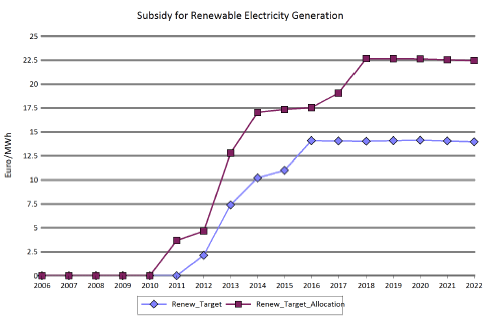
Figure 4: The necessary subsidy for the marginal renewable generation with and without allocation to new entrants. The subsidy could also be interpreted as the expected costs of green certificates if a Green Certificate market were established. The renewable energy target is introduced in 2010.
Conclusions
The present study shows that allocation to new entrants will have the following long-term consequences if the allocation principles from the 2005-7 National Allocation Plans are continued:
- Investments in new capacity will shift from gas power and renewables to coal power, increasing CO2-emissions by 40 million tonnes/year in the long term (a 6 per cent increase)
- Investments primarily take place in Germany, because allocation here is more generous than in the Nordic countries
- Electricity prices will decrease– particularly in Germany – because allocation to new entrant will stimulate investments in new power capacity with low short-term marginal costs. Consumers will benefit from this whereas existing electricity producers will lose
- Distortions in the market will lead to a welfare-economic loss of almost €5 billion (net present value) at a CO2-price of 20 euro/tonne. The welfare-economic loss increases with increasing quota prices. This is approximately 25 per cent of investments in the electricity sector in the period 2006-2022. Scaled up to the EU-25 level, this corresponds to a welfare-economic loss of €20 billion if we assume that the loss is directly proportionate to CO2-emissions.
- Carbon prices will rise, and hence excacerbate the welfare-economic loss mentioned above. If carbon prices reach 40 euro/tonne, this may endanger the functioning of the EU ETS as the subsidy for fossil-fuel plants will exceed the investment costs of new power plants.
- The costs of achieving a renewable energy target may be increased significantly due to new entrant allocation. According to the simulations by almost 60 per cent from app. 14 euro/MWh in a situation without new entrant allocation to 22.5 euro/MWh.
The European Commission has recently decided to set up a multi-stakeholder working group reviewing the EU emissions trading scheme. The working group will submit a report by June 2007. We hope that the conclusions from this study will be taken into account in this work.
Dansk resumé
Siden januar 2005 har de mest energiintensive virksomheder i EU været omfattet af EU’s kvotehandelssystem. I teorien vil et kvotesystem give samme incitamenter som et CO2-afgiftssystem, hvor afgiften svarer til kvoteprisen. Tildelingen af kvoter til nye anlæg kan imidlertid have en række utilsigtede virkninger, som bl.a. kan reducere systemets efficiens.
Gratistildeling af kvoter til nye anlæg udgør en investeringsstøtte til nye fossilt fyrede anlæg, og denne støtte modsvares ikke af tilsvarende kvotetildeling til vedvarende energi anlæg, idet der ikke må tildeles kvoter til disse ifølge kvotedirektivet. Gratistildeling af kvoter til nye anlæg påvirker ikke den daglige optimering af anlæggenes drift, men kan influere beslutninger om investeringer i nye anlæg betydeligt.
Med de nuværende EU-regler er det op til medlemslandene, om de vil give gratis kvoter til nyanlæg. For allokeringsperioden 2005-7 har alle lande valgt at gøre dette. I Tyskland er allokeringen særligt favorabel og vil ved en kvotepris på 150 kr./ton kunne dække mere end 50 % af investeringsomkostningen ved at opføre et nyt kulkraftværk.

Figur 1: Allokering til nyt kulfyret kraftvarmeværk i udvalgte europæiske lande. Målt som andel af anlæggets investeringsomkostninger. Kvotepris: 150 kr./ton. Baseret på de nationale allokeringsplaner for 2005-7.
I dette studie vurderes konsekvenser af gratis allokering til nye anlæg vha. af elmarkedsmodellen Balmorel, der simulerer investeringer i det nordiske og det tyske el- og kraftvarmesystem i perioden 2006-2022. De anvendte brændselspriser er baseret på prognoser fra det Internationale Energiagentur, og der er som udgangspunkt regnet med en kvotepris på 150 kr./ton gennem hele perioden. Kvoteallokeringerne til nyanlæg er beregnet på baggrund af de nationale allokeringsplaner for perioden 2005-7.
Gratisallokering til nyanlæg vil, ifølge modelberegningerne, medføre, at investeringer i ny kraftværkskapacitet går fra en kombination af kul, gas og vedvarende energi til næsten udelukkende kulkraft. Samtidigt flyttes investeringerne i nye anlæg til Tyskland, hvor tildelingsvilkårene er mest favorable. Figuren nedenfor viser udviklingen i kraftværkskapacitet i modelområdet uden gratisallokering til nyanlæg og med gratisallokering.

Figur 2: udviklingen i kraftværkskapacitet i modelområdet uden allokering til nyanlæg (figur til venstre: reference) og med allokering til nyanlæg (Figur til høje: new_entrants).
De øgede investeringer i kulkraftværker forårsager, at CO2-emissionen i modelområdet på længere sigt øges med 40 Mt (ca. 6 %) sammenlignet med referencen uden kvoteallokering til nyanlæg.
For elmarkedet medfører kvoteallokeringen lavere markedspriser, fordi der sker flere investeringer i kulkraftværker, som generelt har relativt lave driftsomkostninger. Dette vil være til gavn for elforbrugerne, mens eksisterende elproducenter taber penge. Ændringerne er mest markante i Tyskland, hvor elmarkedsprisen falder fra ca. 37 øre/kWh til ca. 30 øre/kWh.
For samfundet som helhed medfører kvoteallokering til nyanlæg et samfundsøkonomisk tab på ca. 35 mia. kr. over perioden (opgjort som nutidsværdi), fordi investeringerne i markedet ikke er optimale med gratisallokering. Størstedelen af tabet, ca. 30 mia. kr., sker hos tyske aktører. For Danmark indebærer gratisallokeringen et samfundsøkonomisk tab på ca. 0,9 mia. kr.
Ovennævnte resultater forudsætter som nævnt en eksogent fastsat kvotepris på 150 kr./ton. I praksis vil kvoteprisen dannes ud fra udbud og efterspørgsel blandt de kvoteomfattede virksomhederne og mulighederne for at tilkøbe kvoter fra JI og CDM projekter. Allokering til nyanlæg vil bidrage til at øge kvoteprisen, idet tilskuddet til de fossile kraftværker – og særligt kulkraftværker – vil gøre investeringer i fx VE teknologier forholdsvist dyrere. Højere kvotepris medfører imidlertid at gratisallokeringen til nyanlæg ligeledes får en højere værdi. Dette kan medføre en selvforstærkende effekt, som fører til endnu højere kvotepriser. Muligheden for at tilkøbe kvoter fra andre sektorer eller fra JI/CDM projekter må dog forventes at lægge en dæmper på prisstigningerne. Konsekvenserne heraf er ikke analyseret i dette projekt. Såfremt kvoteprisen når et niveau på 40 euro/ton, vil tilskuddet fra gratisallokeringen overstige investeringsomkostningerne for et nyt kraftværk. Dermed er der en teoretisk risiko for, at der bliver etableret nye kraftværker, som der aldrig vil være brug for.
Det er desuden undersøgt, hvorledes gratisallokering til nyanlæg påvirker omkostningerne ved at nå en eventuel VE-målsætning. Konkret vurderer dette studie konsekvenserne at øge VE-andelen i modelområdet med ét procentpoint årligt fra 30 % i 2010 til 42 % i 2022[2]. Simuleringerne med VE-målsætningen viser, at de samlede samfundsøkonomiske tab for modelområdet pga. gratisallokering øges til ca. 41 mia. kr. (nutidsværdi). Desuden bliver det nødvendigt at øge tilskuddet til VE-anlæg fra godt 10 øre/kWh til ca. 17 øre/kWh, fordi deres konkurrenceforhold forværres (beregnet som det nødvendige tilskud for det marginale VE-anlæg).
1 Introduction
In 2003 the EU adopted the directive on a greenhouse gas emissions trading scheme (ETS) encompassing all major energy producing units and the majority of the energy intensive industry. The EU ETS is based on the recognition that creating a price for carbon through the establishment of a market for emission reductions provides the most cost-effective way of complying with international greenhouse gas commitments (EU 2005, EU action against climate change).
The EU ETS does not require member states to allocate quotas for free to new entrants, however all countries have established a reserve for new entrants in the first allocation period. According to the EU regulation only fossil fuel plants can be allocated quotas. This distorts the incentives of the EU ETS because the free quotas are effectively a financial subsidy for the fossil fired plants. Free allocation of quotas to new power plants will have the effect of encouraging fossil fuel power plants on behalf of renewable energy technologies, and may thereby reduce the economic efficiency of the scheme.
Furthermore, differences in allocation principles can affect the timing of investments and the geographical localisation of new plants. This may impact on the security of supply and the functioning of the electricity market.
This project examines the consequences of allocating CO2 allowances to new entrants under the EU emissions trading scheme (EU ETS). These circumstances are illustrated through comprehensive explanations and graphs depicting the competitiveness of different technologies w/without allocation.
To quantify the consequences of allocation in more detail, model-analyses are carried out examining future investments the German and Nordic electricity and district heating markets.
2 Methodology
This project examines the consequences of allocating CO2 allowances to new entrants under the EU emissions trading scheme (EU ETS). The EU ETS includes all major energy producing units and the majority of the energy intensive industry, including among others cement and steel factories. However, in this study focus is confined to the power and district heating sector.
Four hypotheses are examined in the project, namely that allocations to new entrants will:
1) Move investments from renewable energy plants and gas power toward coal power plants (thus increasing CO2 emissions and thereby the demand to buy quotas from other sectors or through the flexible mechanisms of the Kyoto-protocol)
2) Move investments to the countries with the most generous allocation principles (which may erode the security of the power supply in other countries)
3) Move investments in time (the allocation works as an investment subsidy which in a liberalised market is likely to move investments forward in time)
4) Lead to a welfare-economic loss for society because investments in the power and heat sector are skewed away from the optimum (the size of this loss is estimated in the project).
This report is structured in four main chapters.
First (chapter 3), the basics of the EU emissions trading scheme are described, including the theoretical arguments for applying emissions trading as an economic incentive. The chapter also accounts for the approaches used for allocating quotas to new plants in selected North European EU member states.
Secondly (chapter 4), the electricity market is analysed in detail. What are the principles for dispatching power plants in electricity markets and what conditions and criteria are important for investments in new power plants? Our focus is on the market based investment decisions. These issues are important because CO2-allocation to new entrants is effectively an investment subsidy and therefore will become an integrated part of investment decisions. It is examined how free allocation to new entrants can in principle affect technology choice, location of new plants and timing of investments. These circumstances are illustrated by the use of comprehensive explanations and graphs demonstrating the competitiveness of different technologies w/without allocation.
To show the consequences of allocation in more detail model analyses are carried out examining future investments the German and Nordic electricity and heat markets (chapter 5). The calculations are made using Balmorel (See www.balmorel.com and appendix A), which is an economic partial equilibrium model which includes detailed information of power/heat plants and electricity transmission system in the affected countries. With the model it is possible to determine how investments and production patterns will develop depending on the allocation conditions for new plants. Two basis simulations are compared: a simulation with allocation to new entrants and a simulation without new entrant allocation.
In addition sensitivity analyses are made examining:
- Economic consequences of different CO2-price levels
- Economic consequences of a lower discount rate
- Impacts of combining the CO2-emissions trading scheme with renewable energy targets
- Impacts on the CO2-price level when emissions are capped and consequent economic consequences
The results from the model provide an overview of investments in different technologies, fuel use, CO2-emissions and generating costs. By comparing the costs and prices in the different simulations it is possible to estimate the welfare-economic loss of allocating quotas to new entrants.
The more detailed modelling assumptions are accounted for in Appendix A.
3 The EU ETS
- 3.1 Fundamentals of the EU ETS
- 3.2 Allocation to new entrants
- 3.3 NAP changes from 2005-7 to 2008-2012
In accordance with the Kyoto Protocol the EU15 countries are committed to reducing their greenhouse gasses by 8 percent in 2008-2012 compared to the 1990 level. This overall target has been transferred into national goals for the individual EU member states according to the EU burden sharing agreement. The new EU member states are not encompassed by the burden sharing agreement, but have individual targets of 6 or 8 percent reduction according to the Kyoto Protocol.
The EU’s emissions trading scheme is one of the European Union’s most important measures to combat climate change and to comply with its international commitments. According to the preamble of the ETS directive it should be used as a means to fulfil Kyoto commitments through an ”efficient European market in greenhouse gas emission allowances, with least possible diminution of economic development and employment” (EU 2003/87/EC).
Emission trading begins with a limit or cap on total emissions. By allowing permits/quotas to be traded among stakeholders a market for allowances is created. Economic theory suggests that a trade takes place when a source faces higher marginal costs in reducing its emissions than another source. Market players facing the least costs should be willing to reduce their emissions below their own limit in order to generate permits for sale, whereas market players with high abatement costs should abstain from reducing their emissions. The greater the difference in the marginal costs of reduction among agents, the higher is the benefit of a trading system (IEA/OECD, 2001, OECD, 1993).
3.1 Fundamentals of the EU ETS
The EU ETS includes all EU member states and more than 10,000 production units, including the majority of the energy sector and the energy intensive industry including the off-shore sector. On the EU level app. 45 percent of total CO2 emissions are covered by the scheme corresponding to an annual allocation in the first trial period of approximately 1,800 allowances (1,800 Mt CO2).
The system operates with phases; the first is a trial period going from 2005-2007, i.e. before the commitment period under Kyoto. The second phase runs from 2008-2012 (EU 2003/87/EC, Art. 11) in parallel with the first Kyoto obligation period. Subsequent phases run over 5 years synchronously with the next Kyoto obligation periods.
Every company encompassed by the directive receives an amount of quotas each year and by the 30th of April the following year (EU 2003/87/EC, Art. 12), the companies have to submit quotas to the member state corresponding to their emissions the first year. By placing the deadline for submission of quotas four months within the following year the liquidity of the system is increased because companies by this time have received quotas for the subsequent year. One quota equals the right to emit one tonne of CO2-equivalents in a given period.
By capping emissions from the encompassed companies and by allowing the companies to exchange quotas a market and a price of CO2 are established.
The graph below shows the development of the CO2-price since January 2005 when the EU ETS started. It appears that the price has been quite volatile stretching from 7 to 30 euro/tonne. The steep drop in prices in April 2006 is due to the fact that reported emissions from incumbents were significantly lower than expected by the market.
By end May 2007 quotas for 2007 were traded at app. 0.3 euro/tonne and quotas for 2008 at app. 24 euro/tonne.
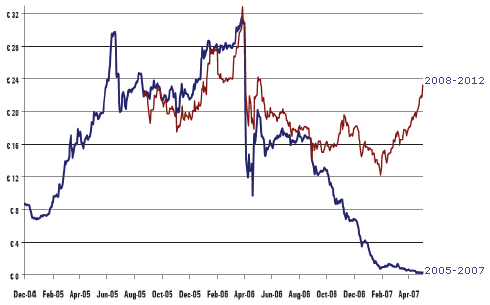
Figure 5: The price of CO2 in the EU ETS (Jan. 2005- May 2007) according to Point Carbon 2007 (Carbon Market Europe, 25 May 2007)
As it is seen from Figure 7, market liquidity has been rising ever since the start up of the scheme from less than 1 Mt tonne per day in early 2005 to more than 6 Mt daily today.
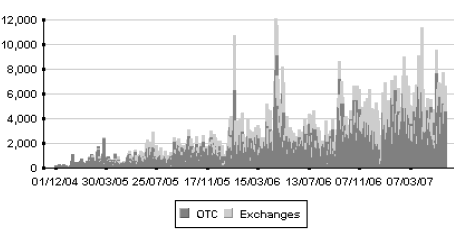
Figure 6: Aggregated volumes (kt) of EU allowances traded Over The Counter (OTC) and at exchanges. The graph covers all vintages (allowances for 2005, 2006, 2007 and 2008). Source: www.pointcarbon.com, 30-05-2007.
If a company does not have enough quotas to cover its emissions, it has to pay a penalty of 40 Euro per tonne CO2 in the period from 2005-2007 and 100 Euro per tonne CO2 in the forthcoming periods. Importantly, the payment of the penalty does not release the company from surrendering the missing amount of quotas the following year (EU 2003/87/EC, Art 16).
The number of allowances for the individual production units is specified in National Allocation Plans (NAPs). The NAPs are to be approved by the EU Commission, and the total amount of quotas should reflect the countries’ objectives according to the Kyoto-protocol and the EU burden sharing agreement. According to the EU “Allocations to installations must take account of their potential for reducing emissions from each of their activities, and must not be higher than the installations are likely to need” (EU 2005, EU action against climate change)
In the first allocation period from 2005-7 at least 95 percent of quotas should be allocated to the installations for free, according to the directive and in the second phase this regards 90 percent of the quotas. The remaining quotas may be auctioned off by the member states.
The EU ETS does not require member states to allocate quotas for free to new entrants. In fact, the Commission takes the view, that “having new entrants buy allowances in the market or in an auction is in accordance with the principle of equal treatment.” (EU Commission 2006, COM(2006)676 final). In practice, however, all countries have established a reserve of free allowances for new entrants in the first allocation period. According to EU legislation only fossil fuel plants can be allocated quotas.
As is the case with the governments on the national level, companies under the EU ETS are allowed to use the flexible mechanisms of the Kyoto protocol; Joint Implementation (JI) and Clean Development Mechanism (CDM) to comply with their targets. In the longer perspective it is possible that the EU ETS will merge with similar schemes in other countries with Kyoto-obligations. According to the EU ETS directive “Agreements should be concluded with third countries listed in Annex B to the Kyoto Protocol which have ratified the Protocol to provide for the mutual recognition of allowances between the Community scheme and other greenhouse gas emissions trading schemes”. The extension of the emission trading scheme to global partners is also one the elements in the EU Commissions communication on “External energy relations” from October 2006 (Com(2006) 590 final).
In a first phase relevant countries to link-up to could be Norway, Switzerland and New Zealand and in the longer term for example Russia, Canada or Japan. In addition the EU has considered linking up to the schemes being planned in the North-Eastern States of the US and in California (Point Carbon, 13-11-2006).
By 30 June 2006 the EU member states should have submitted National Allocation Plans for the second emissions trading period (2008-12) to the EU Commission for approval and 1 January 2007 the allocation for individual installations should be finalised.
During 2006-2007 the EU commission reviewed the EU ETS directive examining if amendments are needed in the period beyond 2012 (EU, 15 May 2006: EU emissions trading scheme delivers first verified emissions data for installations). Recently is has been decided to set down a multi-stakeholder working group reviewing the EU emissions trading scheme submitting a report by June 2007 (http://ec.europa.eu/environment/climat/emission/-review_en.htm, 22/12-2006). Adaptations to the design of the EU ETS arising from this review should take effect at the start of the third trading period in 2013 according to the Commission (EU COM(2006)676 final)
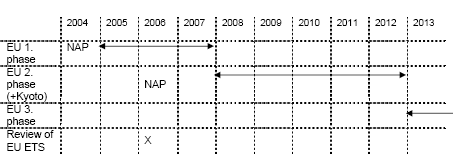
Table 3: Overall time schedule of the EU emissions trading scheme. The deadline for the submission of the NAP was the 31st of March 2004 (1st of May for the new member states) for phase 1 and 18 months before the start up of phase 2 (30th of June 2006)(EU 2003/87/EC: Art. 11).
3.2 Allocation to new entrants
The allocation methodologies to new entrants for the period 2005-7 vary from country to country. In some countries the allocation is based solely on the capacity (electric capacity, heat capacity or thermal capacity) or the expected output of the new plant, putting the different fossil fuel technologies on an equal basis. With this allocation principle a new coal fired plant will be allocated as many allowances as a new gas fired plant. This approach is for example used in Denmark and Sweden.
In other countries the allocation to new entrants is technology or fuel dependent. The principle idea is that for instance a new coal fired plant emits more CO2 than a gas fired plant and therefore needs be to be allocated more quotas for its operation. This is for example the case in Germany and Finland.
The table below shows how many quotas Denmark, Sweden, Finland, Germany and the UK allocate to new coal and gas fired plants producing combined heat and power. In Denmark, Finland and the UK allocation depends on the capacity of the power plants whereas it depends on projected generation in Germany and Sweden[3].
| Coal CHP plant | Gas CHP plant | Annotations | |
| Denmark | 1710 Q/MWel + 350 Q/MWheat |
1710 Q/MWel + 350 Q/MWheat |
Allocation is independent of fuel/technology and projected generation |
| Sweden | 212 Q/GWhel + 66 Q/GWhheat |
212 Q/GWhel + 66 Q/GWhheat |
Allocation is based on the plant’s projected generation (GWhel and GWhheat) |
| Finland | 1596 Q/MWthermal | 1212 Q/MWthermal | Assuming base load plants. Peak load plants will be allocated less quotas |
| Germany | app. 750 Q/GWhel + app. 290 Q/GWhheat | app. 365 Q/GWhel + app. 215 Q/GWhheat | Allocation is based on the plant’s projected generation (GWhel and GWhheat) |
| UK | 4130 Q/MWel | 2390 Q/MWel | CHP plants should comply with the requirements for so-called Good Quality CHP (min: 20 % el. eff.). Assuming heat sale for households |
Table 4: Allocation methodologies for new CHP plants in different EU countries. Annual allocation of quotas (Q). Based on NAPs for 2005-7.
The German allocation to new entrants depends on the emissions from the specific plant in question. However, no plant will be allocated more quotas than 750 per GWhel or less than 365 quotas per GWhel. The minimum benchmark of 365 Q/GWhel is based on efficient modern gas power plants. If the emission factor of a specific plant is higher than 365 Q/GWhel the plant owner must supply documentation stating that Best Available Technology is applied.
Table 5 below provides an overview of allocation principles for condensing plants. In Sweden allowances are only allocated to plants producing combined heat and power.
| Coal cond. Plant | Gas cond. Plant | Annotations | |
| Denmark | 1710 Q/MWel | 1710 Q/MWel | Allocation is independent of fuel/technology and projected generation |
| Sweden | 0 | 0 | Condensing plants are not allocated quotas |
| Finland | 1596 Q/MWthermal | 1212 Q/MWthermal | Assuming base load plants. Peak load plants will be allocated less quotas |
| Germany | Max. 750 Q/GWhel | Min. 365 Q/GWhel | Allocation is based on the plant’s projected power generation (GWhel). |
| UK | 1830 Q/MWel | 2030 Q/MWel |
Table 5: Allocation methodologies for new condensing power plants in different EU countries. Annual allocation of quotas (Q). Based on NAPs for 2005-7.
Some countries have specified for how long the new plants will receive allocations. In Germany for example new plants will receive quotas for the subsequent 14 years. In Denmark on the other hand the allocation methodology in principle only accounts for the period 2005-7 and it is therefore uncertain if new plants will receive allowances beyond this period.
Figure 7 below illustrates how new entrant allocation differs between the selected European countries. The graph, which builds on the allocation principles described in Table 4 and Table 5, shows that are significant disparities in the number of quotas for new power plants, particularly for new coal fired units.
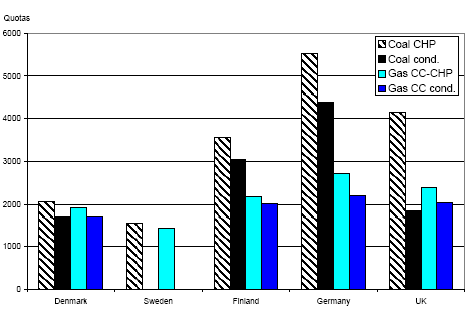
Figure 7: Annual allocation to new coal and gas units per MW electricity capacity. In Sweden and Germany allocation is based on projected electricity and heat generation. In the figure we assume 6000 full-load hours of electricity generation for the new units and 4000 full-load hours heat generation for the CHP plants. New plants are assumed to be highly efficient (El-efficiencies for coal condensing: 52.5 % and for gas CC- condensing: 60 %).
3.2.1 Reserves
The annual reserves for 2005-2007 for new entrants in Denmark, Finland, Germany, Sweden and the UK are depicted in the table below.
| Denmark | Finland | Germany | Sweden | UK | |
| Mill. tonne | 1.0 | 0.83 | 3.0 | 0.73 | 15.6 |
| % of total allocation | 3 % | 2 % | 0.6% | 3 % | 6 % |
Table 6: Reserves for new entrants NAPs for 2005-7
In Germany the reserve for new installations is 3 Mt CO2 p.a. in 2005-7 (9 Mt CO2 in total, equivalent to 0.6per cent of the ET budget). It is important to notice that if the actual need exceeds the size of the reserve, additional certificates will be purchased and distributed free of charge. The purchased amount is to be deducted however when the allocation for the second trading period is determined (Umwelt Bundes Amt, 2005).
In Denmark the reserve for new entrants is 1 Mt CO2 p.a. (equivalent to 3per cent of the ETS budget). Allowances are distributed on a “first come – first served” basis and unused allowances in reserve will be cancelled.
Finland has established a reserve of 0.83 Mt CO2 p.a. (2.5 Mt CO2 in total, 2per cent of the ETS budget). Any surplus allowances may be sold by the state.
Sweden has a reserve of 0.73 Mt p.a. (equivalent to 3.2per cent of the ETS budget).
In the UK the reserve for new entrants is 15.6 Mt CO2 p.a. (equivalent to 6per cent of the ETS budget). The reserve will be distributed on a first come – first served basis and any allowances remaining at the end of the phase may be auctioned.
3.3 NAP changes from 2005-7 to 2008-2012
This project builds on the national allocation plans for 2005-7 (NAP I) because to this day Commission decisions on the NAPs for 2008-2012 (NAP II) have not yet been made for all countries under analysis.
A look into the NAP IIs indicates the following main changes:
- Sweden intends to allocate more quotas to new entrants (67 % increase)
- Denmark intends to allocate less quotas to new entrants (30 % decrease)
- The EU Commission has questioned the German 14-year allocation guarantee to new entrants saying that a new power plant can only be treated as a new entrant in one trading period. In the following trading periods the new entrant should be treated on the basis of the general allocation methodology which is used for otherwise comparable existing installations. It is yet to see how this decision will be reflected in the revised German NAP. If the 14-year guarantee is removed this will reduce investor certainty about future allocation to new entrants. However, the EU decision does not say that new entrants in one period may not receive quotas for free in a subsequent period. Therefore it seems probable that new entrants will also receive some level of allocation for the subsequent periods in Germany.
The changes in allocation principles from NAP I to NAP II are not expected to alter the main conclusions of this study.
The changes from NAP I to NAP II are described in more detail for Denmark, Finland, Germany and Sweden below.
3.3.1 Denmark
The NAP II will reduce the allocation to new entrants by 30 per cent compared to 2005-7. Moreover allocation to peak power plants will be reduced. The reserve for new entrants is reduced from 1 Mt annually to 0.5 Mt.
The Commission has not yet made any decision to approve or reject the Danish NAP II.
3.3.2 Finland
No changes compared to the NAP I regarding allocations to new power plants. New entrants during NAP I are also treated as new entrants under NAP II.
The Commission has not yet made a decision to approve or reject the Finish NAP II.
3.3.3 Germany
Germany intends to use the same coal and gas benchmarks as for the 2005-7. Allocation is no longer based on projections of electricity and heat production but on standard factors which are 7500 full-load hours for coal and gas CC.
The 14-year allocation guarantee to new entrants still applies according to the German plan. However, the Commission has subsequently made a decision on the plan saying that a new power plant can only be treated as a new entrant in one trading period. In the following trading periods the new entrant should be treated on the basis of the general allocation methodology which is used for otherwise comparable existing installations. It is yet to see how this decision will be reflected in the revised German NAP.
The reserve is raised to 12 Mt per annum and if the need exceeds the size of the reserve, additional certificates will be purchased and distributed free of charge as it was the case for the first NAP.
3.3.4 Sweden
In order to harmonise allocation with neighbouring countries more quotas are allocated to new entrants than in NAP I. Allocation to electricity producing plants is raised from 202 allowances per MWh projected electricity generation to 337 allowances. Allowances are still only allocated to combined heat and power plants.
An annual reserve of 3 Mt is set a side for each year in the period 2008-2012. This is significantly more than in the first NAP (0.73 Mt per annum).
4 The electricity market – impacts of allocation to new entrants
When assessing the impacts of emissions trading on the electricity sector it is important to distinguish between the electricity spot market where existing power plants compete in day-ahead markets and the long term development of the power market taking into consideration investments in new power plants.
4.1 Electricity spot-market
Generally speaking the EU ETS should stimulate the following CO2 reduction measures in the electricity spot market:
1) Fuel switching (coal => gas => nuclear/renewables)
2) Improvement of the fuel efficiency
3) Energy savings and efficiency
The driver behind all three measures is the extra cost operators of CO2 emitting plants are imposed and the corresponding increase in the power market price caused by the scheme.
Most power markets, including for example the Nordic, the German and the UK market, rely on day-ahead auctions (spot market) where generators submit individual bids of quantity and price. Together with consumers’ demand these bids determine the market price. The market supply curve is found by summing the individual plants’ supply curves horizontally - this implies, in an efficient market, ranking the individual generators by their marginal cost. The spot price is therefore determined by the marginal supplier.
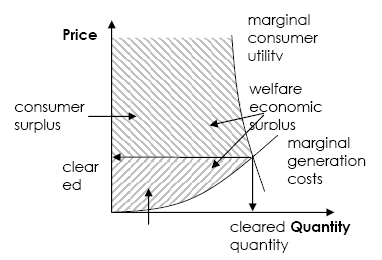
Figure 8: Assuming perfect competition, Power plants offer capacity according to their marginal generation costs. In the spot-market the market-price is equivalent to the marginal generation cost of the marginal power plant. The difference between the marginal utility of consumers and the marginal generation costs makes up the welfare-economic surplus of electricity generation.
Assuming perfect competition in the spot market, power plants offer capacity at their short run marginal costs (SRMC) according to economic theory. The SRMC corresponds to the cost of producing one extra unit of electricity at existing plants. The costs include fuel costs, variable operation and maintenance costs and any environmental costs that have been internalised in the market. Units with no or low fuel costs like wind, hydro power, nuclear and coal have relatively low SRMC, whereas gas or oil power plants have relatively high SRMC.
At times where electricity demand is relatively low (for example in summer time or at night) the market price will be fixed by units with low SRMC and vice versa in times with high demand. This fact is depicted in the graph below assuming no cost of CO2.
Figure 9: Supply and demand in the electricity spot-market
When CO2-costs are added gas and renewable energy power plants will become more competitive compared to coal power. Moreover, energy producers will get an incentive to run the power plants with high fuel efficiency, for example plants producing combined heat and power.
Adding CO2-costs may change the merit order of power plants as indicated in the figure below where coal moves up to become more expensive than gas power.
Figure 10: Including a CO2 price can change the merit order in the spot market
Based on the new merit order a new, higher price level is established. The relative cost increase of the various power plants depends on the fuel (emission factor), the fuel efficiency of the plant and the price of CO2. The increase in electricity prices is the extra cost of the marginal plant in each time segment. In time segments where renewable energy plants, nuclear or gas powered plants set the price there will be no or a quite low increase in the cost of power, whereas the increase may be quite significant in hours where coal or oil powered plants are marginal.
Figure 11: Supply and demand in the electricity spot-market, including CO2.
Table 7 shows how much the SRMC will increase for selected power plants, assuming a CO2 price of 20 euro/tonne.
| CO2 emission factor (tonne/TJ) | Electric efficiency, % | Emissions (kg/MWh) | Cost increase (€/MWh) | |
| Coal | 95 | 40 % | 855 | 17 |
| Gas CC | 57 | 50 % | 412 | 8 |
| Gas engine | 57 | 35 % | 589 | 12 |
| Oil | 78 | 35 % | 802 | 16 |
Table 7: The impact of CO2-quotas on the SRMC of selected fossil fuel technologies (condensing plants). Assumed CO2 quota price: 20 euro/tonne.
Experience from the Nordic market shows that the average emissions of the marginal power plant is approximately 700 g/kWh. This was for example reflected in the developments in electricity prices in connection with the release of 2005 verified emissions data in May 2006, when CO2-prices dropped from 30.6 Euro/tonne till 13.0 during one week (the CO2-price dropped because the actual level of the 2005 emissions were lower in aggregate than expected by many market observers). During the same week electricity prices declined by 12.7 euro/MWh, from 51.5 Euro/MWh to 38.8 Euro/MWh. Assuming that the change in the cost of allowances is the only reason for the decline in the electricity price (the interpretation by market analysts) this indicates that the emissions of the average marginal power plant is 720 g/kWh (12.7 euro/MWh / 17.6 euro/tonne = 0.72 tonne/MWh). Model analyses of the Nordic electricity system have shown a similar outcome (Elkraft System, 2003).
It is important to note that according to economic theory plant owners should add the cost of CO2 to their SRMC irregardless of the amount of quotas they have been allocated. The reason for this is that even if the plant has excess quotas, these quotas have a value determined by the market for quotas. If power is not produced and no CO2 emitted the quotas could otherwise be cashed for money (opportunity cost perspective). The degree to which the cost of quotas will be passed onto the SRMC could however be minimised if companies expect their future allocation of quotas to be impacted by their current level of production or emissions. This market failure, often referred to as “updating”, may appear, when allocation follows a sequential process, i.e. where allocation plans are decided for one commitment period at a time. Several studies have dealt with the issue of updating, see for example Neuhoff et al. (2006) for a comprehensive analysis.
In addition to stimulating changes on the production side, the demand will also be impacted by higher prices. An incentive is provided to reduce demand and invest in energy efficient end-use technologies leading eventually to reductions in CO2-emissions.
Increasing electricity prices will also add to the revenue of power producers. Assuming the marginal plant in the market emits 700 kg CO2/MWh as shown in the section above, the electricity price will increase by 14 euro/MWh on average. This almost covers the CO2-costs of a coal powered power plant (see Table 7). Allocation of free quotas to fossil fired plants based on their historic emissions or electricity generation can therefore be viewed as double-compensation.
In the spot market the EU ETS is an efficient tool to reduce CO2 emissions. Gas, nuclear and renewable energy power plants become more competitive compared to coal power, incentives are provided to run plants with high fuel efficiency and electricity prices increase – thereby stimulating energy efficiency/saving measures among consumers. Allocation to new fossil fuel plants will not have any direct impacts on the spot market. In the longer term allocation to new entrants may however change investments patterns (to be discussed below) and thereby the composition of power plants in the spot market.
4.2 Investments in power plants
Basic economic theory states that investments in the liberalised power market should take place when the (wholesale) price of power exceeds the long run marginal cost (LRMC) of producing power from a new power plant (IEA, 2003: 33). From an investor point of view many uncertainties are faced when considering investing in a new plant. How will fuel prices develop? Heat prices? CO2-prices (and other environmental costs)? And most importantly, how will the power price develop over time? Most power plants are capital intensive and have long technical life times (>15y) making them highly dependent on the future development in the market.
In the previous non-profit system the guaranteed market for power and the pre-paid power plants provided a very high degree of security for the economy of new plants. In the market based system the revenue in the spot market should be able to cover capital cost and other fixed cost of a new power plant. This is depicted in the figure below showing a fictive duration curve of the hourly electricity price.
In the hours where the electricity market price is higher than the plant’s SRMC a surplus revenue is generated to cover the fixed costs. When prices in the market are lower than the plant’s SRMC it is unprofitable for the generator to produce power. Figure 12 illustrates this principle on a price-duration curve - a method of illustration often used in the energy sector, where a value (e.g. price) which varies over time for some duration is represented by sorting in descending order, making it possible to identify e.g. profits as areas below the curve.

Figure 12: Duration curve of electricity prices. When the electricity market prices exceed the SRMC of the power plant revenue is generated to cover the plants capital costs and other fixed costs.
It can be assumed that the risk associated with investments in the liberalised will urge investors to require higher risk premiums than in the previous regime. This could for instance manifest it self in a demand for higher rates of return, when the feasibility of different investments are analysed – thus giving preference to technologies with low capital costs where fewer resources are risked.
A simple way to compare the relative attractiveness of different investment options in the electricity sector is to calculate their LRMC. The LRMC is the reduced average cost per unit of electricity produced taking into account all capital and operating costs.
Figure 13 compares the cost of five state-of-the art technologies in 2015: coal, gas, biomass, wind and nuclear[4]. All thermal technologies produce combined heat and power and the income from the heat sale has been deducted from the fuel costs indicated in the graphs (this explains the relative low fuel costs of for example the coal powered plant in the figure). Investment costs have been reduced over the economic life-time of the plants assuming a rate of return of 10 per cent (including investor risk premium).
The fuel prices for the figure below are based on the projections in the IEA World Energy Outlook 2006, assuming a crude oil price of 48 $/tonne in 2015 and coal prices at approximately the same level as today. The generation cost of the biomass plant is illustrated by using two sets of fuel prices, 2 euro per GJ and 4 euro per GJ respectively[5]. The first case illustrates a situation where the biomass is available as a residual product at a low cost subject to availability (e.g. residuals from a paper mill) and the second case a situation where the biomass is procured at world market prices.

Figure 13: Long Run Marginal Costs of new power plants
When the costs of CO2 is added to the LRMC (see Figure 14) it will become more attractive to invest in technologies with no or low CO2-emissions. Adding CO2 should also give incentives to invest in more efficient power plants, for example through the generation of combined heat and power. Investors in heat only plants should observe higher electricity prices and thus find greater incentive to combine the production of heat and power. Similarly it would become more attractive for owners of power plant to use the excess heat for district heating as well.

Figure 14: Long Run Marginal Costs of new power plants including the cost of CO2 (assuming a CO2 price of 20 euro/tonne.)
Allocation to new entrants under the EU ETS may however erode the incentives of the scheme. Figure 15 shows the LRMC of new power plants, when allocation to new fossil fired units is taken into consideration. In this case the allocation to new entrants is based on the German NAP. The dotted part of the bars indicate the cost of CO2 (assumed CO2 price: 20 euro/t). When allocation to new entrants is included the LRMC falls to the level of the red lines. It appears that when allocation to new entrants is included coal and gas fired power plants become significantly more attractive for investors. In the base case without allocation to new entrants gas and wind power are almost equally competitive. However, when including allocation to new entrants both gas and coal power plants become more attractive for investors than wind power.
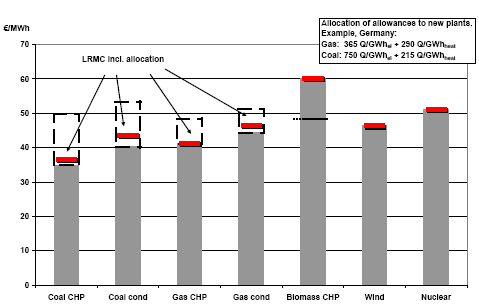
Figure 15: Long Run Marginal Costs of new power plants including the cost of CO2 (assuming a CO2 price of 20 euro/tonne.) and allocation to new entrants. Companies will receive their allocation annually. For the calculations in this figure, the value of future allowances has been reduced to net present value using a discount rate 10 % over time horizon of 10 years. Based on NAPs for 2005-7.
Figure 16 shows how great a share of total CO2-cost, which are covered by new entrant allocation for a new German power plant.
Allocation to new entrants will thereby lead to more investments in fossil fuel technologies and this way to increased CO2 emissions from the European energy sector. Alternatively, if the total cap remains unchanged, the increase in emissions will lead to higher carbon prices, which may stimulate more investments in low-carbon technologies, but also increase the purchases of credits from JI and CDM projects. Moreover, higher carbon prices will also increase the value of allocations to new entrants leading to self-perpetuating process. This issue will be dealt with in detail in section 5.7.1.
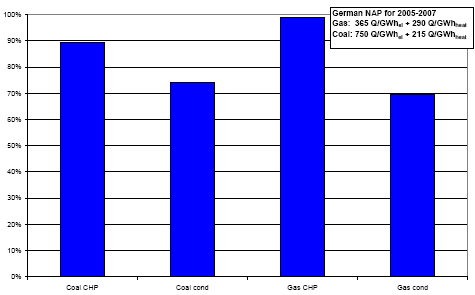
Figure 16: Share of CO2-costs covered by new entrant allocation. Companies will receive their allocation annually. For the calculations in this figure, the value of future allowances has been reduced to net present value using a discount rate 10 % over time horizon of 10 years. Based on the German NAPs for 2005-7.
Next to impacting the choice of technology, allocation to new entrants can also affect the geographical distribution of new investments. In Figure 17 the allocation to a new coal fired power plant is compared for five North European EU countries.
In Germany the allocation to new entrants is rather generous and the income from the sale of quotas is able to cover more than 60 per cent of total capital costs assuming a CO2-price of 20 euro/tonne. In Sweden the same figure is less than 20 per cent. A similar pattern is observed for gas power plants though the difference between countries is smaller (se Figure 18).
The large differences between countries can move investments from countries where they are most needed, from a market perspective or security of supply perspective, to countries with excess capacity where they are of less benefit.
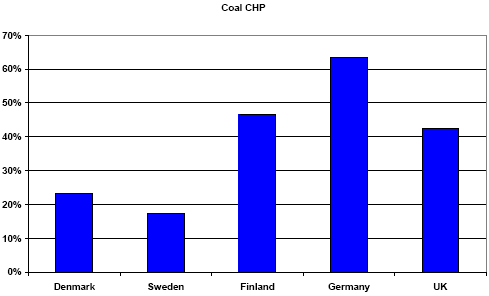
Figure 17: Allocation to new coal fired plants in selected EU countries. Measured as share of the plants total capital costs. CO2-price: 20 euro/tonne.
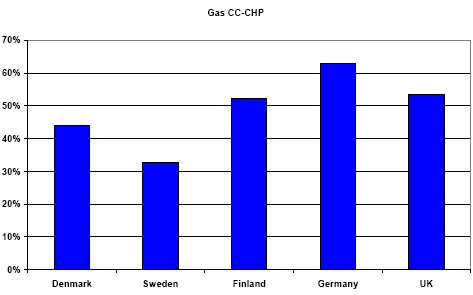
Figure 18: Allocation to new gas fired CHP-plants in selected EU countries. Measured as share of the plants total capital costs. CO2-price: 20 euro/tonne.
Allocation to new entrants may also affect the timing of new investments in the electricity market. As a rule of thumb, the electricity price in an underinvested market will increase until it reaches the LRMC of a new power plant. Since allocation to new entrants lowers the LRMC of the next power plant this is likely to move investments forward in time (see Figure 19). As a consequence more capacity may be deployed than what is economically efficient.
The support to new entrants can be compared to the fixed capacity payments, which are used in some countries – e.g. Spain, Argentina, Columbia and Chile – to ensure sufficient peak load capacity (Nordel, 2002). However, in the case of the EU ETS the support is only given to fossil fired plants.
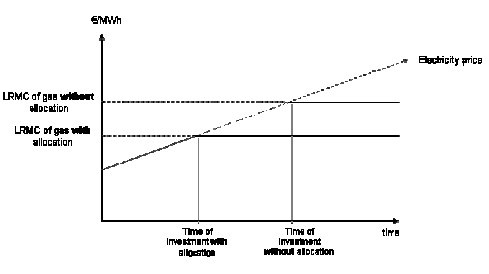
Figure 19: Timing of investments with- and without allocation to new entrants.
In summary, the EU ETS provides incentives to invest in technologies with low or no carbon emissions. Because of the allocation to new entrants these incentives are reduced in some countries eroding the incentives of the CO2-scheme.
5 Model analyses
- 5.1 Modelling tool
- 5.2 Key assumptions
- 5.3 Welfare-economic losses
- 5.4 Investments in electricity generation capacity
- 5.5 Impact on electricity prices
- 5.6 Emitted CO2
- 5.7 Additional simulations
- 6 % discount rate
To analyse whether the hypotheses presented in the previous sections have merit, a number of quantitative simulations have been performed using the Balmorel model.
The Balmorel model covers the electricity and district heating sector of the Nordic countries and Germany. With the model it is possible to determine how investments and production patterns will develop depending on the allocation conditions for new plants.
Two basis simulations are compared: a simulation with allocation to new entrants and a reference simulation without new entrant allocation. In addition sensitivity analyses are made examining the impacts of combining the CO2-emissions trading scheme with renewable energy targets and varying key parameters such as the CO2-price and investors rate of return.
5.1 Modelling tool
The Balmorel[6] model is a dynamic partial equilibrium model which simulates welfare-economic optimal dispatch of generation capacity, consumption, transmission as well as performing investments in generation technology endogenously.
In the model the Nordic countries are divided into 10 areas on the electricity side, separated by transmission links. Finland is one area, Norway consists of four areas, Sweden of three, and Denmark of two areas. The German system is divided into three areas.
The Balmorel model is among others used by the Danish Transmission System Operator - Energinet.dk, the consulting group COWI, the Risø National Laboratory · Technical University of Denmark – DTU, Informatics and Mathematical Modelling at the Technical University of Denmark and EA Energy Analyses.
Studies, which have been carried out with the model, include analyses of the benefits of the Great Belt connection by Elkraft System (2005) (Transmission System Operator of Eastern Denmark until 1.1.2005), analyses of the NorNed cable for NVE (by COWI and Ramløse-EDB), simulations and analyses of the electricity markets in Poland and the Baltic countries (in connection with the project Common Baltic Electricity Market) (Eesti Energia et al., 2005) and an analysis of introducing 50 per cent wind power in the Danish electricity system (Ea Energianalyse, 2007).
The model and key model assumptions are described in more detail in Appendix A.
5.2 Key assumptions
The simulations in the present study assume competitive markets and perfect foresight over a one year horizon.
Investments are assumed to take place in an electricity market with no subsidies or other incentives except for the CO2-scheme. The annualised costs are based on a specified discount rate. In the base calculations a discount rate of 10 % is used. This represents the investor’s demand for rate of return of the investment.
Fuel prices in the reference analyses are based on the latest projection by the IEA (World Energy Outlook 2006) and a CO2-price of 20 euro/tonne is applied.
| EURO/GJ | Light oil | Fuel oil | Coal | Natural gas | Straw | Wood |
| 2007 | 9.0 | 5.0 | 2.0 | 4.9 | 4.5 | 4.4 |
| 2010 | 9.1 | 5.1 | 1.8 | 5.0 | 4.5 | 4.4 |
| 2015 | 9.0 | 5.0 | 1.8 | 5.0 | 4.5 | 4.4 |
| 2020 | 8.8 | 4.9 | 1.8 | 5.1 | 4.5 | 4.4 |
Table 8: Fuel prices used in the model (based on the IEA World Energy Outlook 2006). Gas prices in Denmark and Finland are as depicted in the table, whereas they are 10 pct. lower in Norway and 10 pct. higher in Sweden. The prices of light oil and fuel oil correspond to a crude oil price of 48 $/bbl in 2015.
Due to ageing three per cent of thermal power capacity is expected to be decommissioned per annum. A specific assumption on generation capacity in Germany concerns the nuclear phase out programme which is assumed to be implemented causing a gradual phase out of all nuclear capacity in the period to 2022.
In the model new investment can be made in coal, gas, wind, biomass and nuclear technologies. However, investments in new nuclear plants are only allowed to take place in Finland, due to the existing policies (the recent change of policy in Sweden towards a more positive approach to nuclear power has not been taken into account). Carbon capture and storage technologies are not included in the analyses.
With respect to free allocation to new entrants, it is assumed that.
- Allocation is based on the principles in the National Allocation Plans for 2005-7. Background: EU decisions are not available for all NAPs for 2008-2012.
- Investors expect free allocations to new entrants over a 10 year period. Background: Some countries have not provided information on the length of allocation. For reasons of simplification we assume that all countries will allocate quotas for two subsequent Kyoto-periods (2*5 years). The German NAP specifies the allocation period to 14 years, but this guarantee has been questioned by the EU commission.
- To determine the size of allocations and expected electricity generation from new plants is 6000 full load hours per annum assuming that the new power plants will provide base-load power. CHP plants are expected to generate 4000 full load hours of heat per annum. The actual resulting operations within the model are likely to defer from these, but as updating is not employed this does not affect allocations.
- The value of the free allocation is based on the actual value of CO2 emissions certificates in the year of investment. The value of future allocations are reduced using a discount rate of 10 % per annum
- No upper limit for quantity of allocations for new plants each year (i.e. no limit to the new entrant reserves in the countries concerned)
- Norway applies the same rules as Sweden (no data was available for Norway for 2005-7).
For a further description of the model assumptions we refer to the Background paper on modelling tool and data assumptions (Appendix A).
5.3 Welfare-economic losses
The Balmorel model has the capacity to quantify welfare-economic losses and gains with respect to alternative policies. For the purpose of these analyses the definition of welfare-economic losses (negative) and gains (positive) are attributed to changes in sum of the economy of all stakeholders.
The relevant stakeholders are
- Consumers
- Producers
- Grid owners
- States
In these simulations a simple level playing field is employed as the benchmark. Hereby, country specific tax regimes and subsidies are disregarded. In the case with free allocations to new entrants these allocations are assumed to be drawn from the pool of free allocations to producers as a whole. Thereby the net-gains/losses born by states are zero by construction.
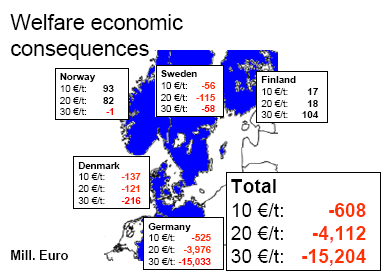
Figure 20: Geographical distribution of Welfare-economic losses and gains. Gains are denoted as positive while losses are negative. Overall the system is subject to a loss of approximately 4.1 billion euros at a CO2-price of 20 euro/tonne. The results show that the countries with the highest degree of allocation to new production units incur the greatest losses.
Figure 20 provides an overview of the simulation results. The figure shows the difference is the welfare-economy between scenarios with and without free allocation for new entrants. The welfare-economic losses are approximately 4.1 billion EUROs in real terms, in the baseline 20 euro/tonne setting, or approximately 25 per cent of the total investments in the electricity sector over period 2006-2022. The losses rise with the CO2-price as the market distortion is proportionate with the value of emissions allowances.
Losses are disproportionately distributed across among groups. Perhaps contrary to some expectations, the group of producers bears the brunt of the economic distortion (see Table 9). There are two reasons for this.
1. Producers tend to profit from operating in a sector characterised by underinvestment. Conversely in an over invested market competition will drive down prices and profits.
2. The group of producers comprises both new and existing production capacity. Since allocations to new entrants are assumed to be deducted from available allocations to producers in general, free allocations to new entrants do not generate additional revenue for the group as a whole.
Consumers, on the other hand, benefit from new entrant allocation because more investments are made in the power capacity, thereby causing lower electricity prices.
Because of its favourable allocation rules for new entrants Germany bears the greatest economic consequences of all the countries sustaining a total loss of 4 bill. euro.
Total economic consequences for Finland and Norway are positive because these countries are in these simulations net importers of electricity and therefore benefit from the decreasing electricity prices, which are a result of allocating quotas to new entrants.
| Mio. EURO | DENMARK | FINLAND | GERMANY | NORWAY | SWEDEN | TOTAL |
| Producer | -1,003 | -1,218 | -33,262 | -2,385 | -2,712 | -40,579 |
| Consumers | 954 | 1,387 | 29,535 | 2,510 | 2,995 | 37,381 |
| Grid owners | -72 | -151 | -249 | -43 | -398 | -915 |
| Total | -121 | 18 | -3,976 | 82 | -115 | -4,112 |
Table 9: Welfare-economic losses and gains distributed on stakeholders. Assumed CO2-price: 20 euro/tonne. The results show that electricity producers suffer significant losses whereas consumers benefit from allocation to new entrants. This is because new entrant allocation produces more investments in the power sector and thereby lowers electricity prices. Economic consequences over the period 2006-2022 have been reduced to 2006 (net present value) using a discount rate of 10 %.
5.4 Investments in electricity generation capacity
Comparing the two main scenarios, i.e. the Reference case and the New Entrants Allocation case the key difference is the incentive for investment. By the introduction of free CO2-quota allocation, the cost of investment for certain technologies is reduced and thereby competition between technologies is skewed on the long-term, as described in section 4.2. Meanwhile the short-term incentives – the dispatching of capacity in the electricity spot market - remain the same. Hereby, the explanations for the welfare-economic distortions, described in section 5.3, are found in the investment depictions below.
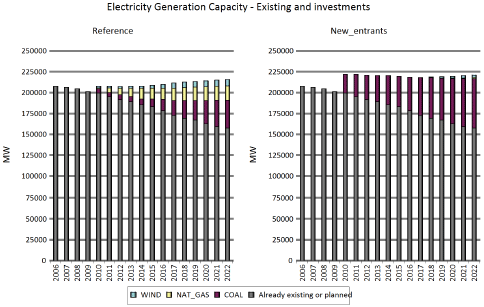
Figure 21: This figure illustrates how investments in new-generation technology replaces or supplements existing technology in the two scenarios. While the reference scenario features an investment mix of coal, gas and wind power, the case with free quotas for new entrants is dominated by coal-fired electricity generation capacity.
Two trends are evident from Figure 21 above.
- While there is a mixture of investments coal, natural gas and wind power in the Reference scenario, coal power is the predominant technological choice when free allocations are given to new entrants.
- The total capacity is somewhat higher in the scenario with an investment subsidy in the form of free CO2-allowances.
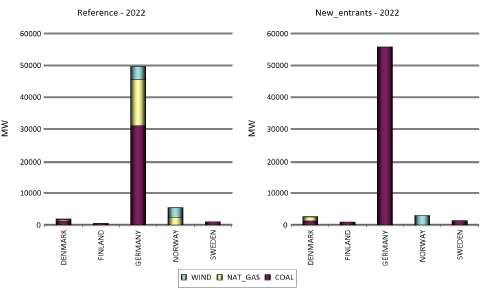
Figure 22: This figure shows cumulated investments in the final year of the simulation (2022) distributed on countries.
Among the countries simulated it is clear that changes in Germany are the most notable. Germany is by far the largest in terms of electricity generation and consumption. Secondly, the nuclear phase out, along with a gradual decommissioning of fossil fuel based thermal power, generates a large demand for investments in new generation units. Thirdly, the impact of the free allocations to new entrants policy is most evident here. The diversity of investments in the Reference scenario is completely absent in the New entrants scenario.
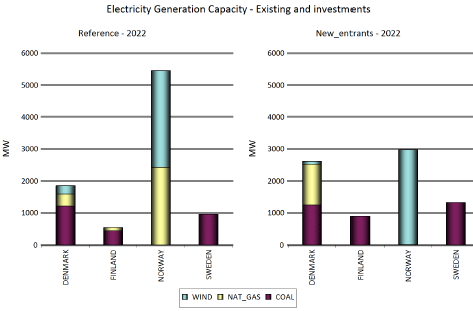
Figure 23: This figure shows cumulated investments as Figure 22 but without Germany. Hereby investments in the other countries can be examined.
The effects of free CO2 allocation to new entrants in the Nordic countries are more easily examined on Figure 23. Additional capacity in Germany, Denmark, Finland and Sweden, removes the necessity of over 2 GW of gas fired generation capacity in Norway. In Denmark investments in wind power are reduced and investments in gas power are increased. Finland increases investments in coal fired capacity and do not invest in gas fired capacity as in the reference scenario. Sweden increases investments in coal fired capacity.
Below shows the value of the CO2-quotas allocated to new entrants.
| Country | Value (mill. €): |
| Denmark | 283 |
| Finland | 195 |
| Germany | 18,970 |
| Norway | 1 |
| Sweden | 116 |
Table 10: Value of allocations to new entrants. Allocations over the period 2006-2022 have been reduced to 2006 (net present value) using a discount rate of 10 % .
The total value of allocations is about 4-5 times the loss sustained by the economy as a whole.
5.5 Impact on electricity prices
Free allocations of emissions certificates to new generation units have no effect on the short-term order of dispatch. Therefore, in the short-term free allocations should not affect electricity prices. This was explained in section 4.1. The presence of additional modern generation capacity as a product of investments does however impact electricity prices. Overcapacity reduces the number of hours where expensive and inefficient peak load facilities need to be in operation.
This effect is most evident in Germany, where the largest number of additional investments was undertaken. Second in line are Denmark and Sweden, Germany’s immediate neighbours.
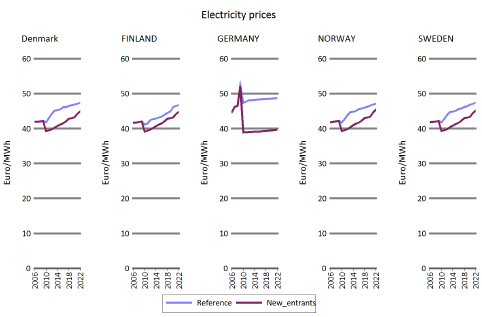
Figure 24: This figure illustrates how the additional capacity affects electricity prices. Price averages are weighted by local consumption representing the average prices as perceived by the electricity consumer.
There is in both scenarios an initial increase in prices followed by a drop in 2010. This occurs due to the assumption of gradual decommissioning of older units, the projected increase in electricity demand, and the lead-time in construction ensuring that the first new entrants enter the market in 2010. Subsequently, prices increase gradually in all countries, following the projected development in fuel prices. In the scenario with free allocations, the gradient of price increase is higher in the countries where a local tightening of the capacity balance occurs, since investments take place in other countries. Thereby, Finland sees the highest price increase gradient and Germany the lowest.
5.6 Emitted CO2
The development in CO2 emissions from the electricity sector in both simulations are compared with emissions in absence of a CO2 limiting scheme. The central forecast indicates that the level of emissions would rise. This growth can be attributed to an assumed increase in electricity demand over the model horizon, as well as the large scale decommissioning of Germany’s nuclear generation capacity.
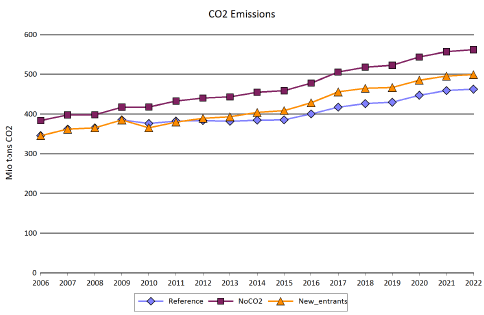
Figure 25: Annual CO2-emissions from electricity generation and district heating.
As the simulated region features a considerable amount of combined heat and power generation (CHP) the CO2-emissions, depicted on Figure 25, result from generation of both electricity and district heating. The NoCO2-label refers to the above mentioned case where no CO2 limiting incentives are present in the market i.e. a CO2 price of zero.
Table 11: CO2-emissions in 2022 in three scenarios
| Scenario | CO2-emissions (megaton/year) |
CO2-reduction from emissions trading (megaton/year) |
| No CO2 limiting incentives | 562 | 0 |
| CO2 regime | 462 | 100 |
| CO2 regime w. quota allocation to new units | 499 | 63 |
A number of observations can be made on the results documented in Figure 25 and Table 11.
- Free allocation to new units reduces the environmental benefits of the EU ETS from the electricity sector from an annual reduction of 100 megatons by 2022 to only 63. In other words the long-term annual reduction in absolute terms is almost halved by free allocations to new entrants.
- Even in the situation with no allocation to new entrants CO2 levels from the electricity sector rise over the simulated period.
The explanation for the later is a combination of several factors:
- With the phase out of nuclear power in Germany a CO2 neutral form of electricity generation needs to be substituted, and in all scenarios fossil fuel based technologies are prevalent
- The assumed price level of CO2-emissions permits is neither sufficient to introduce large amount of renewable energy nor to bring about a shift from coal to gas base load generation technologies.
Moreover, assumed fuel price also impact investment patterns significantly. In this study fuel prices are based on the IEA World Energy Outlook 2006 as explained previously. If the price ratio between coal and gas develop to the benefit of gas this could change investment and production patterns considerably.
5.7 Additional simulations
In addition to the two simulations described above, a number of additional simulations have been performed.
• Impact of free allocation to new entrants in a scenario where CO2-emissions were capped at the 2006 level (in this case the CO2-price is computed endogenously by the model)
• Impact of free allocation to new entrants in a scenario with renewable energy target for electricity generation
• Impact of changing investors’ rate of return to 6 % (as opposed to 10 %).
A scenario with a carbon price of zero (i.e. no CO2 restrictions) was performed to put some perspective on the level of CO2-emissions as has previously been presented. Also, in light of the high level of political interest in renewable electricity generation, a renewable energy target scenario is investigated.
5.7.1 Maintaining CO2-emissions at current levels
An additional simulation has been prepared to examine what CO2-price would be required to maintain emissions in the modelling area at the 2006 level.
To study this, an emissions cap for the simulated system is introduced in the model, limiting total annual CO2-emissions to 345.4 megatons/year. The price of CO2 allowances is then calculated as an output of the model. The results appear from Figure 26. In the long term a CO2-price of app. 25-30 euro/tonne is required to keep emissions under control.
There are no good options for a marginal reduction in emissions in the system other than investments in more CO2 friendly generation technologies. The main measure to curb emission is a shift from coal to gas technologies. At CO2-prices of 20-25 euro/tonne coal-fired technologies seem to have lost their attractiveness all together (se Figure 27, left).
When the same level of CO2-prices are applied in a simulation where investors in new generation units receive free allocations coal becomes an attractive fuel again and approximately 50 per cent of gas power is replaced by coal power (Figure 27, right)
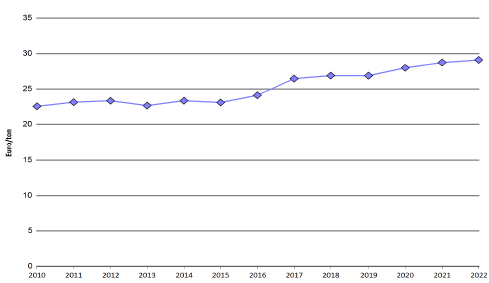
Figure 26: CO2-price with a fixed emissions cap. The steep rise in price from 2006-2009 and subsequent drop in price level is caused by the assumption that no endogenous investments are permitted by the model until the year 2010.
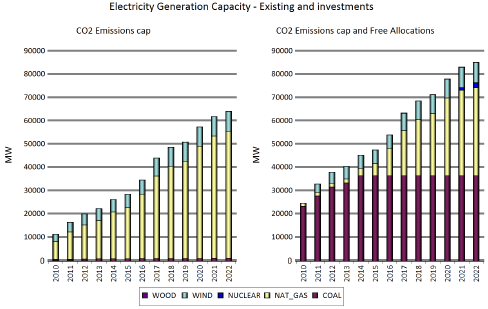
Figure 27: Again the investments are depicted. On the left, an emissions cap has been applied and thus efficient abatement results in a CO2-price for the system (as per Figure 26). On the right, investors in new generation units receive free allocations priced according to the first case.
Free allocation to new entrants effectively increases the CO2-price in a capped system because fossil fuel technologies become cheaper. Thereby a higher CO2-price is needed to stimulate investments in technologies with low or no CO2-emissions.
Therefore it has been attempted to make additional iterations of the above-mentioned simulation with a CO2-cap to examine the consequences of new entrant allocation on the CO2-price.
The iteration steps are described below:
1. Simulation with cap on CO2 => CO2-price deduced by the model
2. Simulation that include new entrant investment subsidy based on the above-mentioned CO2-price => higher CO2 price
3. Simulation that include new entrant investment subsidy based on the above-mentioned higher CO2-price => even higher CO2 price
4. Etc.
The result after only one iteration is a CO2-price of app. 40 EURO/tonne in 2018. However, at this level the reduced value of the allowances to new entrants increases beyond the investment costs of a new power plant, and as a consequence the model generates an excessive amount of generation capacity. Therefore it does not make sense to make further iterations.
These excessive investments are of course not likely to take place in the real world, where investors are likely to have a more holistic approach to new investments and authorities may interfere. Moreover, this calculation does not take into account that quotas can be acquired from other sectors and from JI/CDM, which will contribute to keeping down the price of carbon.
If we assume that allocation to new entrants will cause the CO2 price to increase from 20 euro/tonne in the reference situation to 25 euro/tonne, this will increase the total socio-economic loss in the modelling area dramatically from €4.1 bn. to € 25.8 bn (comparison of the reference scenario with a CO2-price of 20 euro/tonne and no allocation to new entrants with a situation with a CO2-price of 25 euro/tonne and allocation to new entrants) If the carbon price increases further to 30 euro/tonne the loss is €46.2 bn. and at 35 euro/tonne to €67.6 bn. .This is illustrated in Figure 28 below, where the impacts are also distributed on the countries in the modelling area.
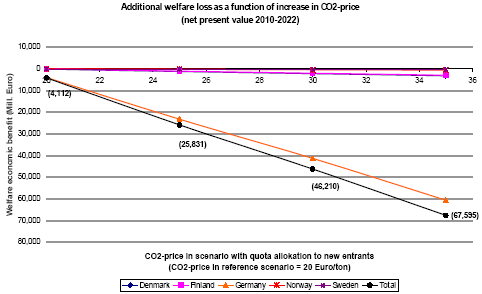
Figure 28: This figure illustrates the welfare economic loss when assuming a CO2 price of 20 euro/tonne in the reference scenario, while CO2 prices are 20, 25, 30 and 25 euro/tonne in the scenario with free allocation to new entrants.
This shows that the possible welfare-economic losses may become significantly higher than €4.1 bn if new entrant allocation affects the CO2-price as the simulations indicate.
5.7.2 Target for penetration of renewables
At this point it is evident that free allocations to new generation units based on the current national allocation plans, strengthens the position of carbon intensive generation technology. An interesting question is how this policy would interact with a possible target for penetration of renewables. To shed light on this two additional simulations have been undertaken.
- The reference scenario is modified to include a minimum percentage of annual electricity generation which must be renewable.
- Secondly this target is applied in conjunction with free allocation to new entrants.
The target percentage ratio for renewable generation is introduced from 2010 at a level of 30per cent - corresponding roughly to the renewable energy ratio in 2010 if no new measures are taken. This target is subsequently increased by 1per cent-point per year to reach 42per cent in 2022.
Figure 29 shows the cumulated investments in the original reference (no RE-target, no free allocation to new entrants), in the case with a renewable target (but no free allocation to new entrants) and in the situation with a renewable energy target and free allocation to new entrants.
The investments in renewable energy capacity are almost identical in the two simulations with renewable energy targets. However, with allocation to new entrants the coal share of fossil fuel capacity increases from app. 60 % to 100 %, at the expense of investments in gas power capacity (reduced from 40 % to 0 %). Moreover, total investments in non-renewable energy plants increase from 37,000 MW to 45,000 MW when new entrant allocation is included.
The majority of RE-investments are made in wind power capacity and towards the end of the period in plants fired with biomass (wood). The shift from wind to biomass reflects that constraints have been implemented in the model on total off- and onshore wind power capacity (physical planning constraints). As the potentials for relatively cheap wind power are used the model invests in biomass capacity.
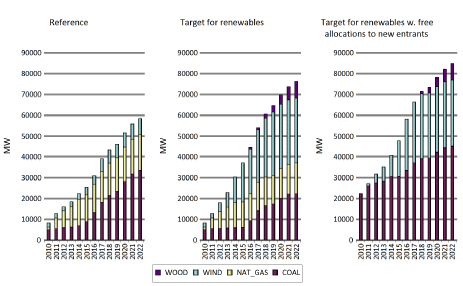
Figure 29: Cumulated investments in the original reference (no RE-target, no free allocation to new entrants), in the case with a renewable target (but no free allocation to new entrants) and in the situation with a renewable energy target and free allocation to new entrants. CO2-price: 20 euro/tonne.
Because of the subsidy to fossil fired plants through the allocation of free quotas to new plants the subsidy for renewable energy plants would also have to be increased to ensure compliance with the RE targets. This is depicted in Figure 30 showing the subsidy which would have to be paid to the marginal renewable generation unit with and without allocation to new entrants.
In both situations the marginal subsidy gradually increases as the most cost-efficient renewable energy technologies are put into play (from on-shore wind power to off-shore wind and biomass). In 2022 the required RE-subsidy is almost 60 % higher in the case with allocation to new entrants, rising from 14 euro/MWh to 22.5 euro/MWh.
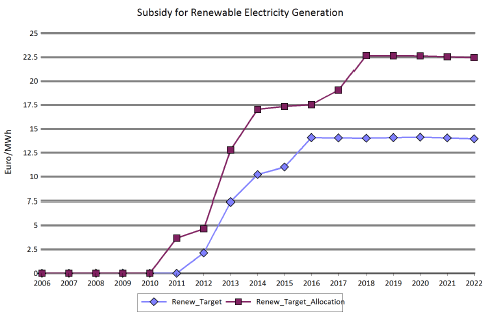
Figure 30: the needed subsidy for the marginal renewable generation unit with and without allocation to new entrants. It could also be interpreted as the expected costs of green certificates if a Green Certificate market was established. The renewable energy target is introduced in 2010.
5.8 6 % discount rate
Changing the investor rate of return and the discount rate to 6 % does not affect the welfare-economic loss of allocation significantly. Assuming a CO2-price of 20 euro/tonne the total loss of new entrant allocation is 4,213 million Euro, when reduced to 2006 (net present value). This should be compared to a loss of 4,112 million Euro when discounting with a rate of 10 %, as it was done in the basis simulation.
6 Summary of observations
The model analyses show that allocation to new entrants will have significant impacts in investment pattern in the electricity market.
- Investments in new capacity will shift from gas power and renewables to coal power increasing CO2-emissions by 40 million tonnes/year in the long term (6per cent increase)
- Electricity price will decrease – particularly in Germany – because allocation to new entrant will stimulate investments in new power capacity with low short run marginal costs. Consumers will benefit from this whereas existing electricity producers will lose
- Investments will move to Germany, because allocation here is more generous than in the Nordic countries
- Investments in new capacity will shift from gas power and renewables to coal power increasing CO2-emissions by 40 million tonnes/year in the long term (6per cent increase)
- Electricity price will decrease – particularly in Germany – because allocation to new entrant will stimulate investments in new power capacity with low short run marginal costs. Consumers will benefit from this whereas existing electricity producers will lose
- Distortions in the market will lead to a welfare-economic loss of almost €5 bn. (net present value) at a CO2-price of 20 euro/tonne. This is approximately 25per cent of investments in the electricity sector in the period 2006-2022. Scaled up to the EU-25 level this corresponds to a welfare-economic loss of €20 bn. if we assume that the loss is directly proportional to CO2-emissions.
- Under an emission cap quota prices will rise, and this may enforce the welfare-economic loss reported above significantly.
- A higher subsidy for RE is required in order to attain RE-targets
7 Conclusion
In the spot market the EU ETS is an efficient tool to reduce CO2 emissions. Gas, nuclear and renewable energy power plants become more competitive compared to coal power, incentives are provided to run plants with high fuel efficiency and electricity prices increase – thereby stimulating energy efficiency/saving measures among consumers. Allocation to new fossil fuel plants will not have any direct impacts on the spot market. In the longer term allocation to new entrants may however change investments patterns and thereby the composition of power plants in the spot market.
The EU ETS provides incentives to invest in technologies with low or no carbon emissions. Because of the allocation to new entrants these incentives are reduced in some countries – thus eroding the incentives of the CO2-scheme.
The present study shows that allocation to new entrants will have the following long term consequences if the allocation principles from the 2005-7 National Allocation Plans are continued:
- Investments in new capacity will shift from gas power and renewables to coal power increasing CO2-emissions by 40 million tonnes/year in the long term (6per cent increase)
- Investments primarily take place in Germany, because allocation here is more generous than in the Nordic countries
- Electricity price will decrease– particularly in Germany – because allocation to new entrant will stimulate investments in new power capacity with low short run marginal costs. Consumers will benefit from this whereas existing electricity producers will loose
- Distortions in the market will lead to a welfare-economic loss of almost €4.1 bn (net present value) at a CO2-price of 20 euro/tonne. This is approximately 25per cent of investments in the electricity sector in the period 2006-2022. Scaled up to the EU-25 level this corresponds to a welfare-economic loss of €20 bn if we assume that the loss is directly proportional to CO2-emissions. The welfare-economic loss increases with increasing quota prices.
- Carbon prices will increase, and hence enforce the welfare-economic loss mentioned above. If carbon prices reach 40 euro/tonne this may even endanger the functioning of the EU ETS as the subsidy for fossil fuel plants will exceed the investment costs of new power plants.
- The costs of achieving a renewable energy target may be increased significantly due to new entrant allocation. According to the simulations by almost 60 per cent from app. 14 euro/MWh in a situation without new entrant allocation to 22.5 euro/MWh.
The European Commission has recently decided to set down a multi-stakeholder working group reviewing the EU emissions trading scheme submitting a report by June 2007. We hope that the conclusions from this study will be taken into account in this work.
8 References
Danish Energy Authority (2006). Vejledning i samfundsøkonomiske analyser på energiområdet
Ea Energy Analyses (2006). Impact of suboptimal design features in the EU ETS. Background paper on modelling tool and data assumptions.
Ea Energianalyse (2007). 50 % vindkraft i Danmark i 2025.
EU 2003/87/EC. Directive establishing a scheme for greenhouse gas emission allowance trading within the Community
EU (2005). EU action against climate change
EU Commission (2006). COMMUNICATION FROM THE COMMISSION TO THE COUNCIL, THE EUROPEAN PARLIAMENT, THE EUROPEAN ECONOMIC AND SOCIAL COMMITTEE AND THE COMMITTEE OF THE REGIONS. COM(2006)676 final
EU Commission (2006). Communication on “External energy relations” from October 2006. Com(2006) 590 final
IEA and OECD (2001) International Emission Trading From Concept to Reality. Paris, France 2001.
IEA (2006). World Energy Outlook 2006
Neuhoff K, Martinez KM, Sato M (2006). Allocation, incentives and distortions: the impacts of EU ETS emissions allowance allocation to the electricity sector. Climate Policy 6, p. 73-91.
Nordel (2002). Peak production capability and peak load in the Nordic electricity market. Nordel and Nordic Council of Ministers. October 2. 2002,
OECD (1993). International Economic Instruments and Climate Change. Organisation for Economic Co-operation and Development.
Point Carbon (2006). Carbon Market News, 13-11-2006
Point Carbon (2007). Carbon Market Europe, 25 May 2007.
Impact of CO2 quota allocation to new entrants in the electricity market
Appendix A:
Background paper on modelling tool and data assumptions
Prepared by
Ea Energy Analyses
Frederiksholms Kanal 1, 1.
1220 Kbh. K
Denmark
Modelling tool
For the present analyses it has been found necessary to work with a model working with a fine time resolution, and high detail level of the Nordic and German power and heat systems.
The Balmorel (Baltic Model of Regional Electricity Liberalisation) model is capable of fulfilling the above demands.
Balmorel - references
The Balmorel model is among others used by the Danish Transmission System Operator - Energinet.dk, the consulting group COWI, the Risø National Laboratory · Technical University of Denmark – DTU, Informatics and Mathematical Modelling at the Technical University of Denmark and EA Energy Analyses.
Studies, which have been carried out with the model, include analyses of the benefits of the Great Belt connection by Elkraft System (2005) (Transmission System Operator of Eastern Denmark until 1.1.2005), analyses of the NorNed cable for NVE (by COWI and Ramløse-EDB), simulations and analyses of the electricity markets in Poland and the Baltic countries (in connection with the project Common Baltic Electricity Market) (Eesti Energia et al., 2005) and an analysis of introducing 50 per cent wind power in the Danish electricity system (Ea Energianalyse, 2007).
For further details on the model please visit www.balmorel.com.
Geographical scope
The version of the model, which has been used for the present analyses, covers the electricity and district heating sector of the Nordic countries and Germany. In the model the Nordic countries are divided into 10 areas on the electricity side, separated by transmission links. Finland is one area, Norway consists of four areas, Sweden of three, and Denmark of two areas. The German system is divided into three areas. Figure 31 and Figure 32 show the division of the transmission grids into system areas.
Data on existing power plants in the Nordic countries have been obtained over the years on the basis of publicly accessible sources, and the data from Germany has been obtained from an EU sponsored research project on implementation of wind power in Northern Europe (WILMAR). Technical data on new plants are based on the Danish Energy Authority’s and the system operators’ Technology Catalogue (Danish Energy Authority et al, 2005).
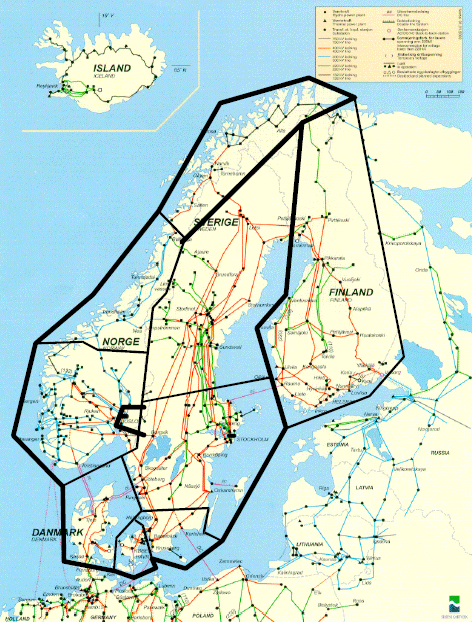
Figure 31: The 10 transmission areas, which the Nordic system consists of in the model.
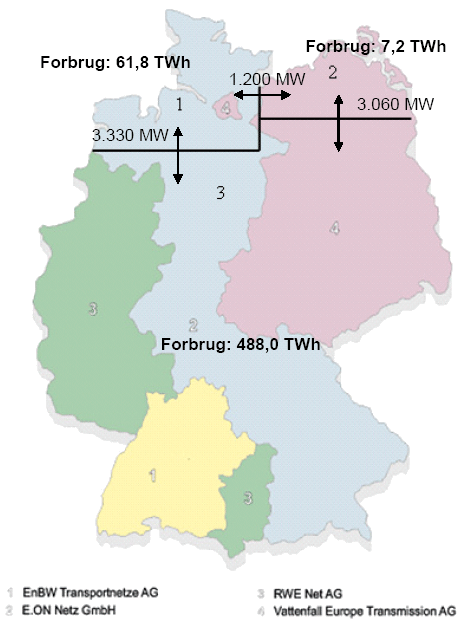
Figure 32: The three transmission areas, which the German grid consists of in the model. 1: Northwest Germany, 2: Northeast Germany, 3: Central Germany.
Optimisation model
The model simulates a well-functioning market and optimises the distribution of production between plants, including import/export conditions. The optimisation seeks to minimise the total cost of the energy system. There is full insight into the distribution of wind production, electricity consumption, inflow of water and outage of power plants. The analyses are thus based on all players having full information at a ”suitable” time before the hour of operation.
As the intention is to evaluate the socioeconomic consequences, actual costs are calculated excluding taxes. However, purchase of CO2 allowances is treated as an actual cost. The model presents results on production, fuel consumption and emissions, together with electricity and heat prices. The model can also optimise investments in new plants. This is used for the analysis of this project.
Investment in new production technologies
A key point in this project is to analyse investments in the power sector under different framework conditions. The Balmorel model is capable of including investments in new technology in the optimisation routine. The model chooses the lowest cost option including existing and new technologies. For new technologies an annualised capital cost is included in the production costs. The annualised costs are based on a specified discount rate. In the base calculations a discount rate of 10 % is used. This represents the investor’s demand for rate of return of the investment. The Balmorel model optimises the power and heat system for one year at the time and, consequently, investments in new technology only takes into account costs in the year of investment. This is a limitation of the model but in a new version investment optimisation over several years will be included.
Data for new technologies has been based on the Danish Energy Authority’s and the system operators’ Technology Catalogue (Danish Energy Authority et al, 2005). For certain technologies, including nuclear and wind power, an upper limit for the quantity of new investments over the period has been set, in order to represents physical and political constraints. Finally, the model is set up to not allow investments before 2010.
Welfare-economic consequences
In a given price area, the producers have a surplus equal to the difference between the production costs and the selling price. Correspondingly, the consumers have a surplus defined as the difference between the buying price and a price equal to the utility value of the electricity. This is illustrated in Figure 33, which shows the supply and demand in a given hour.
The total benefit of electricity generation is the sum of the consumer and producer surplus.
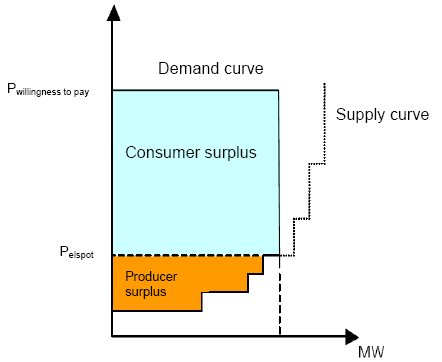
Figure 33: The welfare economic benefit in an area in a given hour. The supply curve shows the marginal costs for the producers in the area. The demand curve shows a price-independent consumption which is cut off at the willingness-to-pay point.
The model calculates the cost of supplying the quantities of electricity and heat demanded. The socioeconomic consequences of different measures in the electricity sector can then be calculated by comparing different model runs.
The economic consequences are broken down for relevant groups of players, including electricity consumers, heat consumers, different groups of producers and the system operators (congestion rents). The entire socioeconomic consequence of measures equals the sum of the consequences for the individual groups. If model calculations are carried out for a number of consecutive years, the welfare economic consequences in future years are reduced to the first year of calculations. The user specifies the discount rate. In the base case a discount rate of 6 % is used.
Distribution of congestion rent
In the modelling results bottleneck incomes on interconnection within the modelling areas (the Nordic countries and Germany) are distributed equally (50-50) between the countries connected. Bottleneck incomes on connections to countries outside the modelling area go to the relevant Nordic country.
Energy system assumptions
This chapter elaborates on the main energy system assumptions. Assumptions are made for the period from 2006-2022, the model simulation time horizon of the analyses. Assumptions on the following main issues are described:
- Generation capacity
- Electricity and heat consumption
- Transmission lines
- Fuel and CO2 prices
Generation capacity
The projections of generation capacity take their starting point in the present capacity in the Nordic and German systems (see Table 12).
| 2006 | Denmark | Finland | Norway | Sweden | Nordic | Germany |
| Power capacity i MW | 13,585 | 16,410 | 27,945 | 32,132 | 90,072 | 114,900 |
| - Hydro power | 0 | 2981 | 27,607 | 15,129 | 45,717 | 8,700 |
| - Nuclear | 0 | 2656 | 0 | 8822 | 11,478 | 20,700 |
| - Natural gas | 2858 | 2002 | 0 | 591 | 5451 | 11,300 |
| - Coal/lignite | 5593 | 3649 | 0 | 1000 | 10,242 | 49,600 |
| - Peat | 0 | 2272 | 0 | 560 | 2832 | 0 |
| - Oil | 1113 | 1608 | 188 | 4590 | 7499 | 10,360 |
| - Municipal waste | 299 | 0 | 20 | 138 | 457 | 800 |
| - Biomass | 566 | 1202 | 30 | 903 | 2701 | |
| - Wind | 3156 | 40 | 100 | 399 | 3695 | 16,660 |
Table 12: Basic assumptions on generation capacity in the Nordic and Germany countries in 2005. Germany data is based on information from Power In Europe, issue 455, July 2005.
Concerning new power plants, projects that have already been decided upon are included in the projection as exogenous investments included in the model. These include among others the new nuclear power plant in Finland, repowering of the Swedish nuclear power plants, a gas based CHP plant in Gùteborg, a gas fired combined cycle plant in Norway and a coal fired plant in Finland – plus investments in wind power capacity in all the Nordic countries. No endogenous investments are included in Germany.
Furthermore a number of old power stations will be decommissioned as a base assumption in the period 2006-22. It is assumed that 3 per cent of all the fossil fired thermal capacity is taken out of operation every year. This adds up to a quite substantial decommissioning of power stations over the period, especially in Germany, Denmark and Finland.
A very important assumption on generation capacity in Germany concerns the nuclear phase out programme. In the model it is assumed that all nuclear power is phased out gradually in the period to 2022. Germany’s nuclear phase out programme was decided by the former government and is expected to reduce nuclear capacity from the present capacity of app. 21,000 MW. In 32 years after the start up of each plant the nuclear power plants are expected to be decommissioned according to the programme.
Wind power production is based on hourly wind power profiles (based on actual production in 2001) from Eastern and Western Denmark. Separate profiles are used for on- and off-shore wind power plants.
In Sweden, Finland, Central Germany and Northeast Germany the profile from Eastern Denmark is applied and in Norway and Northwest Germany the profile from Western Denmark. All wind power capacity in Germany is assumed to be onshore.
Nominal vs. available capacity
The production data include all the capacity. However some of this is not available for the market due to the need for reserve plants and maintenance works. Therefore the capacities of the power plants in the model are derated. The derating figures depend on location and season. During the winter 10-15 pct. of the capacity is not available in the Nordic countries and in the summer time this figure varies between 20 and 40 % depending on time and place (app. 20 % in Eastern Denmark). In Germany app. 10 pct. of the thermal capacity is derated. With respect to hydro power it is assumed that 15 % of generation capacity is not available – this accounts to all countries and all weeks of the year.
Modelling of German power plants
The German power plants are modelled rather coarsely in the Balmorel model consisting of relatively large blocks of plants with identical characteristics, for instance the model include an 8,700 MW coal power plant, an 8,100 MW lignite plant and a 4,600 MW gas power plant. For this reason the supply curve for German power plants is a bit uneven consisting of characteristic price level plateaus (see Figure 34). The actual supply curve for Germany is likely to have a smoother course due to minor differences in the characteristics of the individual plants (electric efficiencies, variable O&M costs, fuel costs etc.).
Figure 34: Supply and demand curves for Germany based on data from WILMAR (2015 fuel and CO2 prices).
Heat and electricity consumption
A limited rise in electricity consumption is assumed throughout the period in Germany as well as in the Nordic countries. In Germany consumption is expected to increase by 0.3 % annually. In the Nordic countries as a whole, electricity consumption is assumed to increase by an average of app. 1 % per year up to 2015, and in Denmark, it is assumed to rise by app. 1.7%. In Denmark’s case, projections of electricity consumption are based on data from Energinet.dk (Eltra and Elkraft System, see Elkraft System 2005), and in the case of the other Nordic countries, on projections from Nordic Grid Master Plan 2002 (Nordel, 2002). Heat consumption is assumed to rise by roughly 0.5% per year up to 2015, after which it is assumed to be constant.
| Country | Denmark East | Denmark West | Finland | Norway | Sweden | Nordic | Germany |
| 2004 | 14.2 | 20.9 | 86,9 | 122,0 | 146,6 | 390.1 | 539.0* |
| 2015 | 17.0 | 25.3 | 96.8 | 138.5 | 156.0 | 433.6 | 555.5 |
| Annual Increase |
1.6 % | 1.8 % | 1.0 % | 1.1 % | 0.6 % | 1.0 % | 0.3 % |
Table 13: Electricity consumption in the Nordic countries and Germany incl. grid losses (TWh/year). *Data from 2002 (Power in Europe, Issue 455, July 2005).
| Country | Denmark East | Denmark West | Finland | Norway | Sweden | Nordic | Germany |
| 2005 | 15.8 | 19.0 | 34.0 | 1.6 | 33.5 | 103.9 | n.a. |
| 2015 | 16.6 | 20.4 | 35.4 | 2 | 34.8 | 109.2 | 93.6 |
| Annual increase | 0.5% | 0.7% | 0.4% | 2.3% | 0.4% | 0.5% | n.a. |
Table 14: Heat consumption in the Nordic countries and Germany incl. grid losses (TWh/year)
The consumption profiles from the Nordic countries are based on public data from Nordpool for 2001. Figure 35 shows the electricity consumption profile used for Eastern Denmark.
The hour-by-hour heat consumption profiles for all system areas are based on standardised data from the central heating systems of Copenhagen from 2001.
Figure 35: Electricity consumption profile for Eastern Denmark (hour-by-hour in 2015)
Transmission lines
It is assumed, that Nordel's "prioritised cross sections" are all established (600 MW each). As on January 3 2006 final decisions have been made regarding four of the five transmission lines. Only Skagerrak 4 has not yet reached a final decision. Furthermore the Estlink cable (350 MW, completion scheduled for end 2006) between Finland and Estonia are both assumed constructed but the NorNed cable between Norway and the Netherlands is not included.
In addition the connection between Denmark West and Germany is expected to be increased from the present 1200/800 MW to 1400/1400 MW.
Table 15 shows the assumed transmission capacities within the modelling area (i.e. the Nordic countries plus Germany).
In addition the model includes the following interconnections to third countries:
Finland – Estonia: 350 MW
Finland – Russia: 1500 MW
Connections from Finland to Russia and Estonia are handled as firm power imports using an hour-by-hour profile. Figure 36 shows assumptions on the average weekly import from Russia and Estonia to Finland.
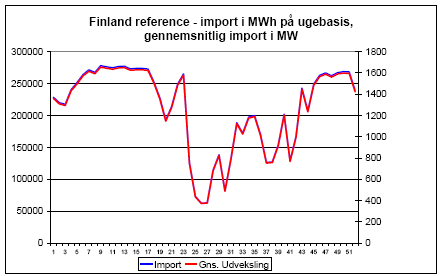
Figure 36: Average weekly import from Russia and Estonia to Finland (left-y: MWh/week, right-y: average MWh/h, x-axis: hours).
The import from Russia and Estonia is assumed to be 11 TWh/year.
No transmission capacities between Germany and its neighbouring countries in Central Europe are included in the analyses.
Table 15: Assumed transmission capacities (MW) within the Nordic countries and Germany in 2015.
Fuel and CO2 prices
Fuel prices are based on the IEA’s ”World Energy Outlook 2006”.
| EURO/GJ | Light oil | Fuel oil | Coal | Natural gas | Straw | Wood |
| 2007 | 9.0 | 5.0 | 2.0 | 4.9 | 4.5 | 4.4 |
| 2010 | 9.1 | 5.1 | 1.8 | 5.0 | 4.5 | 4.4 |
| 2015 | 9.0 | 5.0 | 1.8 | 5.0 | 4.5 | 4.4 |
| 2020 | 8.8 | 4.9 | 1.8 | 5.1 | 4.5 | 4.4 |
Table 16: Fuel prices used in the model (based on the IEA World Energy Outlook 2006). Gas prices in Denmark and Finland are as depicted in the table, whereas they are 10 pct. lower in Norway and 10 pct. higher in Sweden.
The CO2 allowance price is estimated at DKK 150/tonne in the base calculations for 2006-22.
References
Danish Energy Authority (2005). Danish Energy Strategy 2025. Available at www.ens.dk.
Danish Energy Authority, Elkraft System, Eltra (2005). Technology Data for Electricity and Heat Generating Plants (Technology Catalogue). March 2005. Available at www.ens.dk.
Eesti Energia, Latvenergo, Lietuvos Energija, Elkraft System, COWI (2005). Power sector development in a Common Baltic Electricity Market. Financed by the Danish Energy Authority. Available at www.energinet.dk.
Elkraft System (2005). Long-term challenges in the electricity system – wind power and natural gas. Available at www.energinet.dk.
IEA (2005). World Energy Outlook 2006
Nordel (2002). Nordic Grid Master Plan 2002. Available at www.nordel.org.
Power In Europe (2005). Issue 455, July 2005
Footnotes
[1] We use the NAPs for 2005-7 since EU decisions are not available for all NAPs for 2008-2012. Changes in allocation principles from NAP I to NAP II are not expected to affect the main conclusions of this study.
[2] Det har ikke været muligt at belyse, hvordan denne målsætningen stemmer overens med EU's målsætning om 20 % VE-andel af bruttoenergiforbruget i 2020, idet EU's målsætning ikke er opgjort på lande/sektorer.
[3] The Finnish NAP indicates specific emission coefficients per MJ fuel. As full-load hours for new plants are also specified in the plan allocations to new entrants are essentially dependent on the plants’ thermal capacity.
[4] The new plants are assumed to be highly efficient: electrici efficiencies for coal condensing: 52.5 %, gas CC- condensing: 60 %, biomass CHP: 46.5 %.
[5] 4 €/GJ corresponds the international biomass price, which the Danish Energy Authority recommends for welfare-economic analyses in the energy sector (Danish Energy Authority 2005). 2 € reflects a case biomass is available as a residual product at a lower cost.
[6] The Balmorel model is an open source model. The full program code as well as a functional dataset describing the Nordic region and descriptions of various applications can be found on the Balmorel project homepage at www.Balmorel.com.
Version 1.0 June 2007, © Danish Environmental Protection Agency